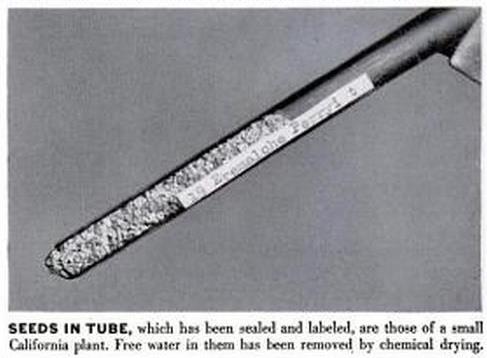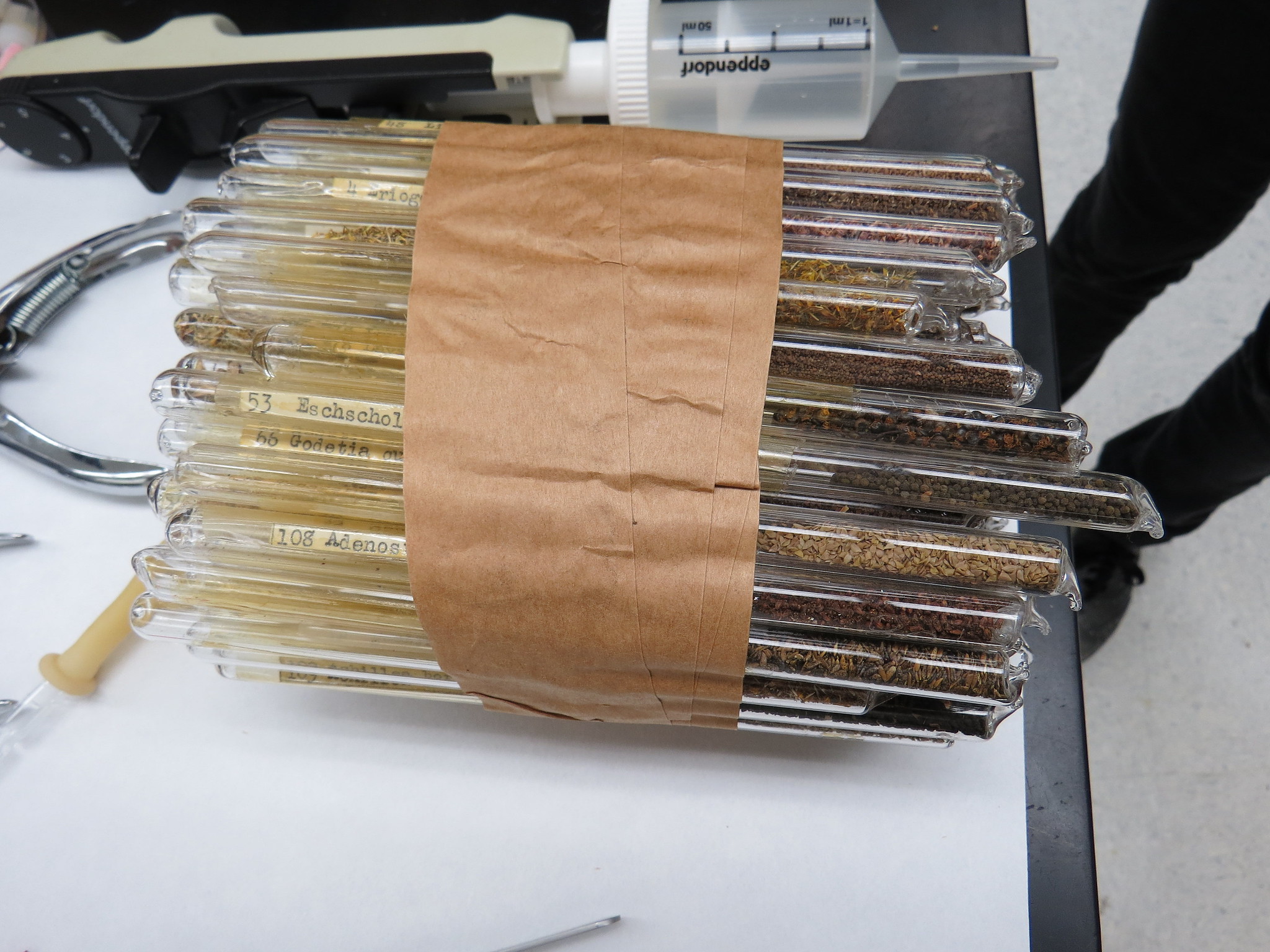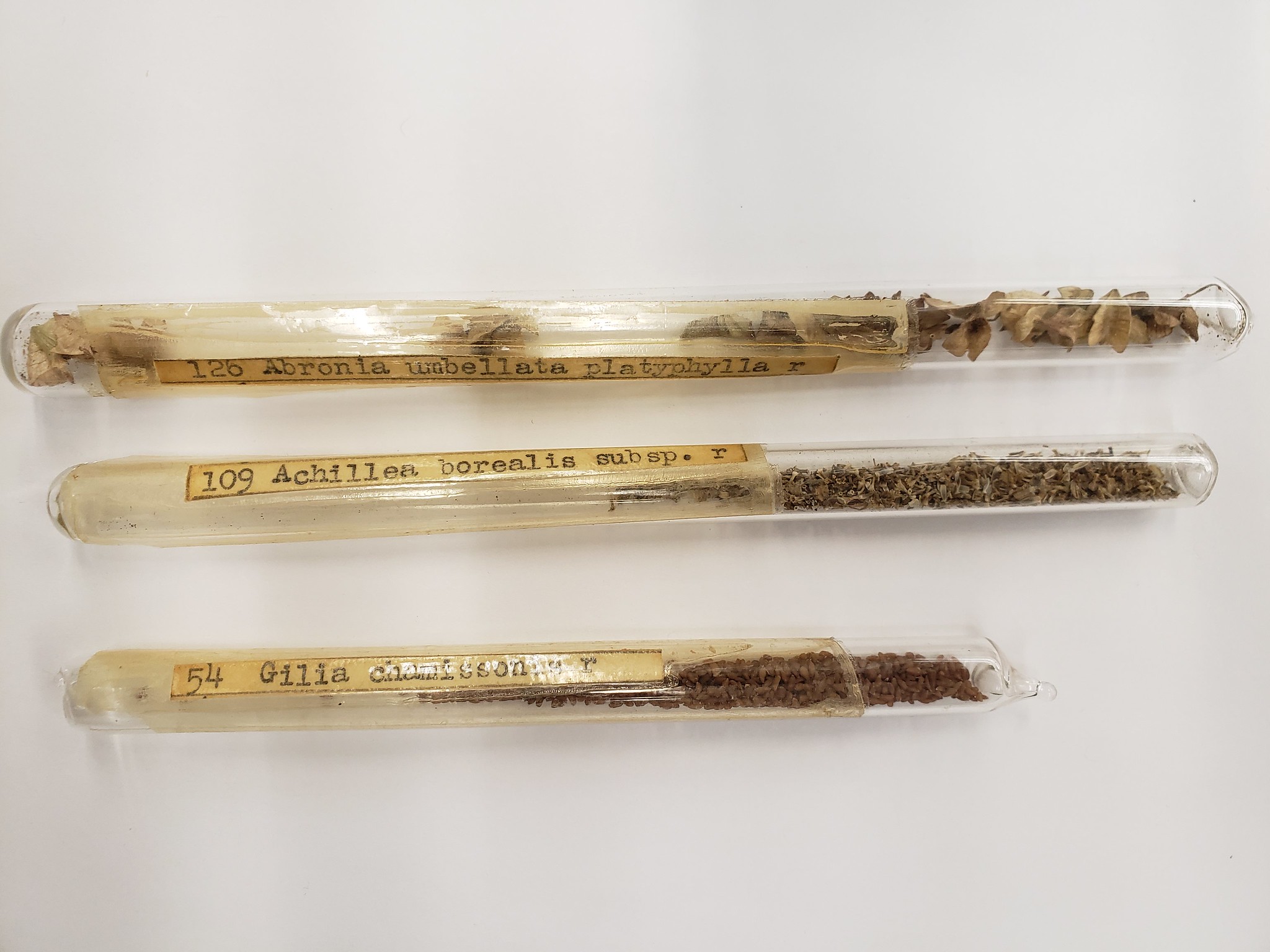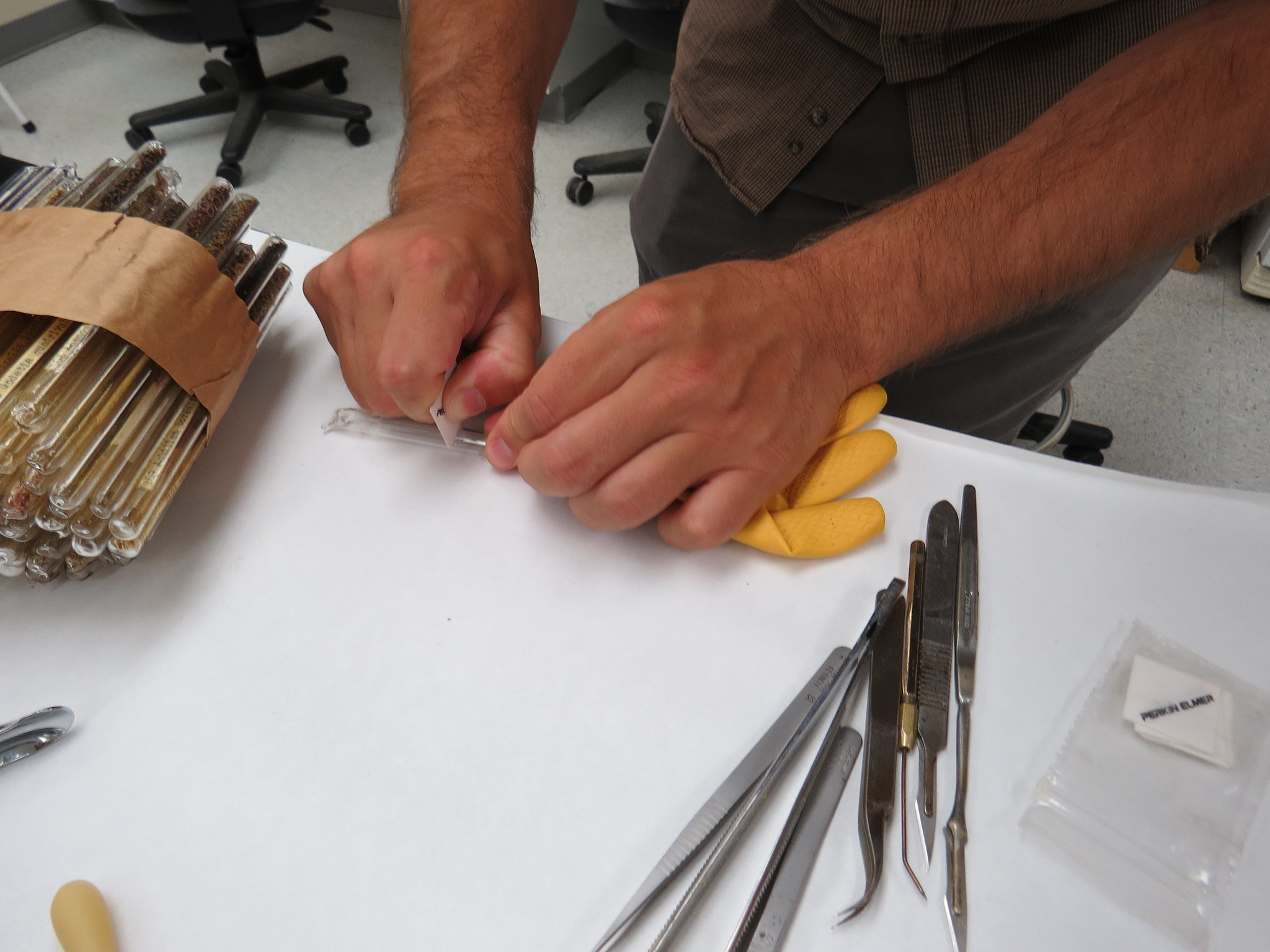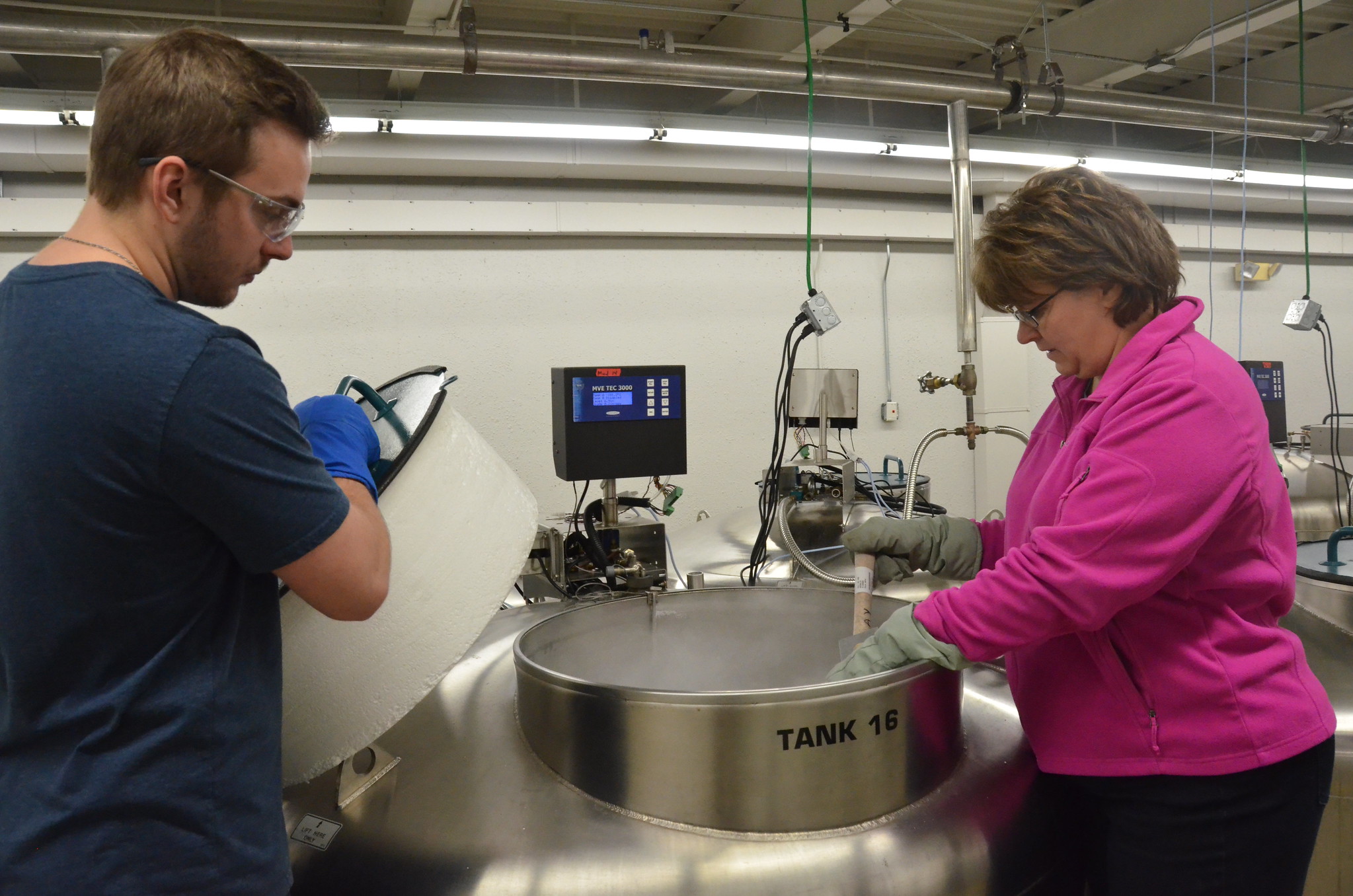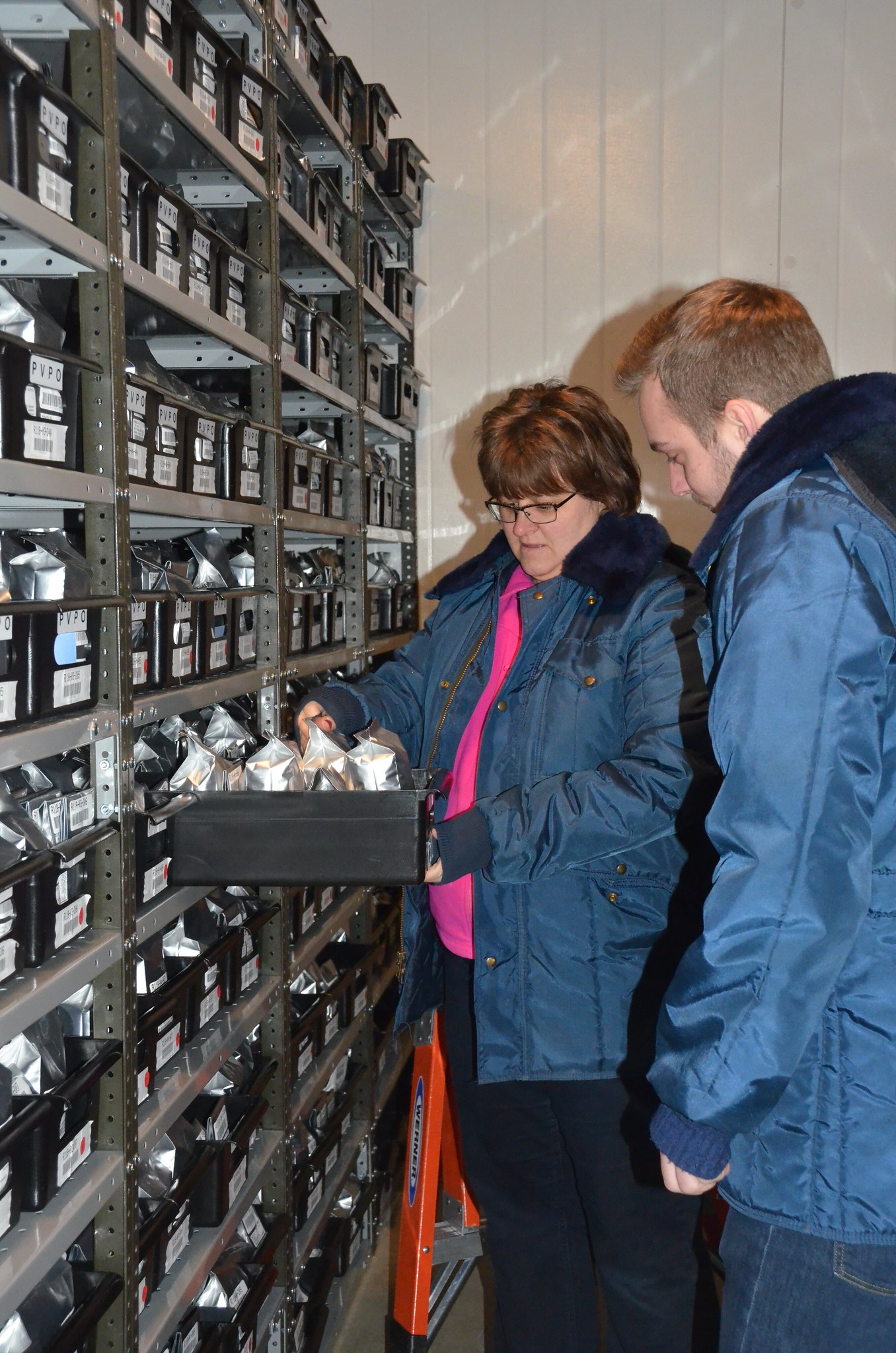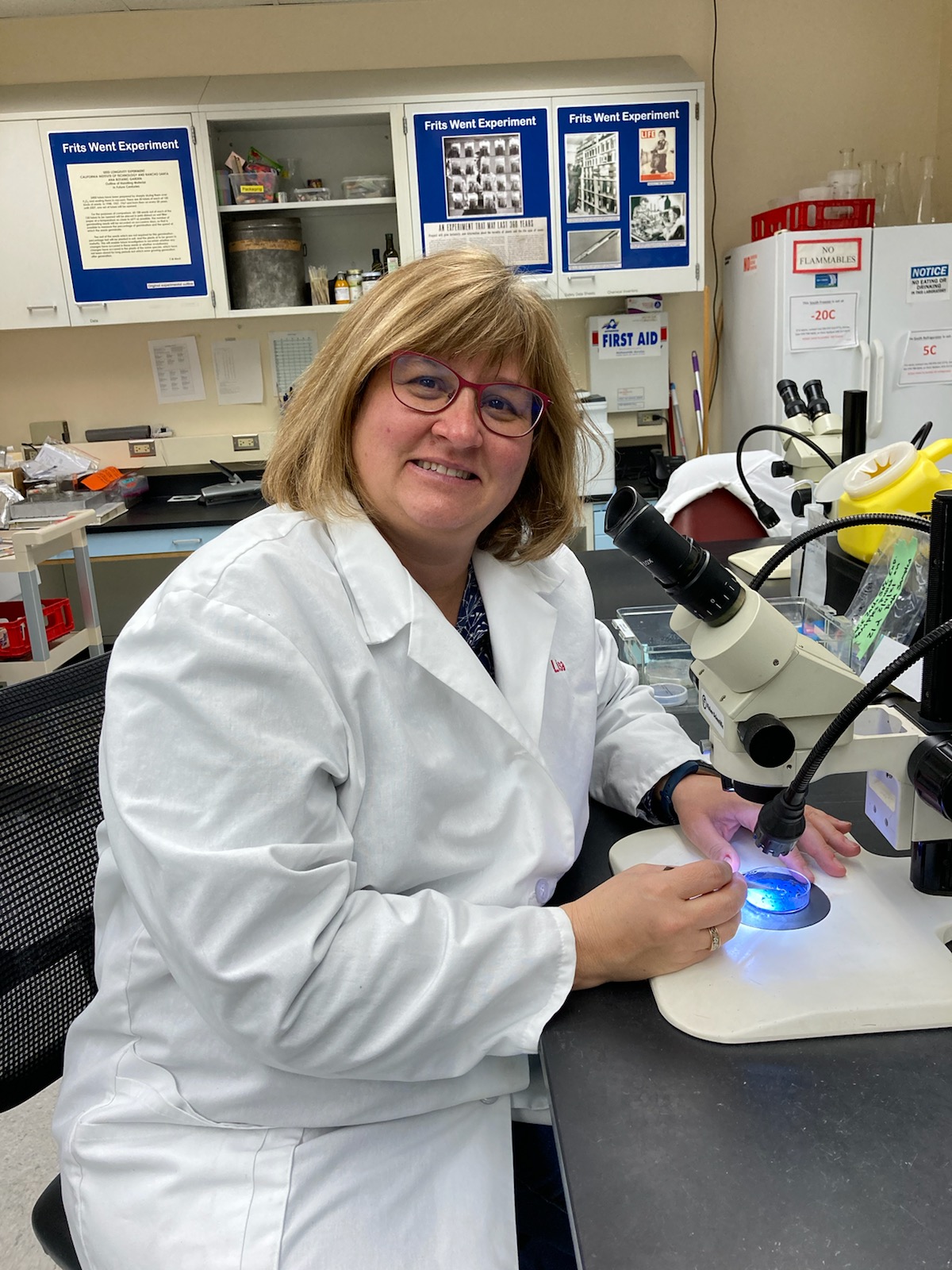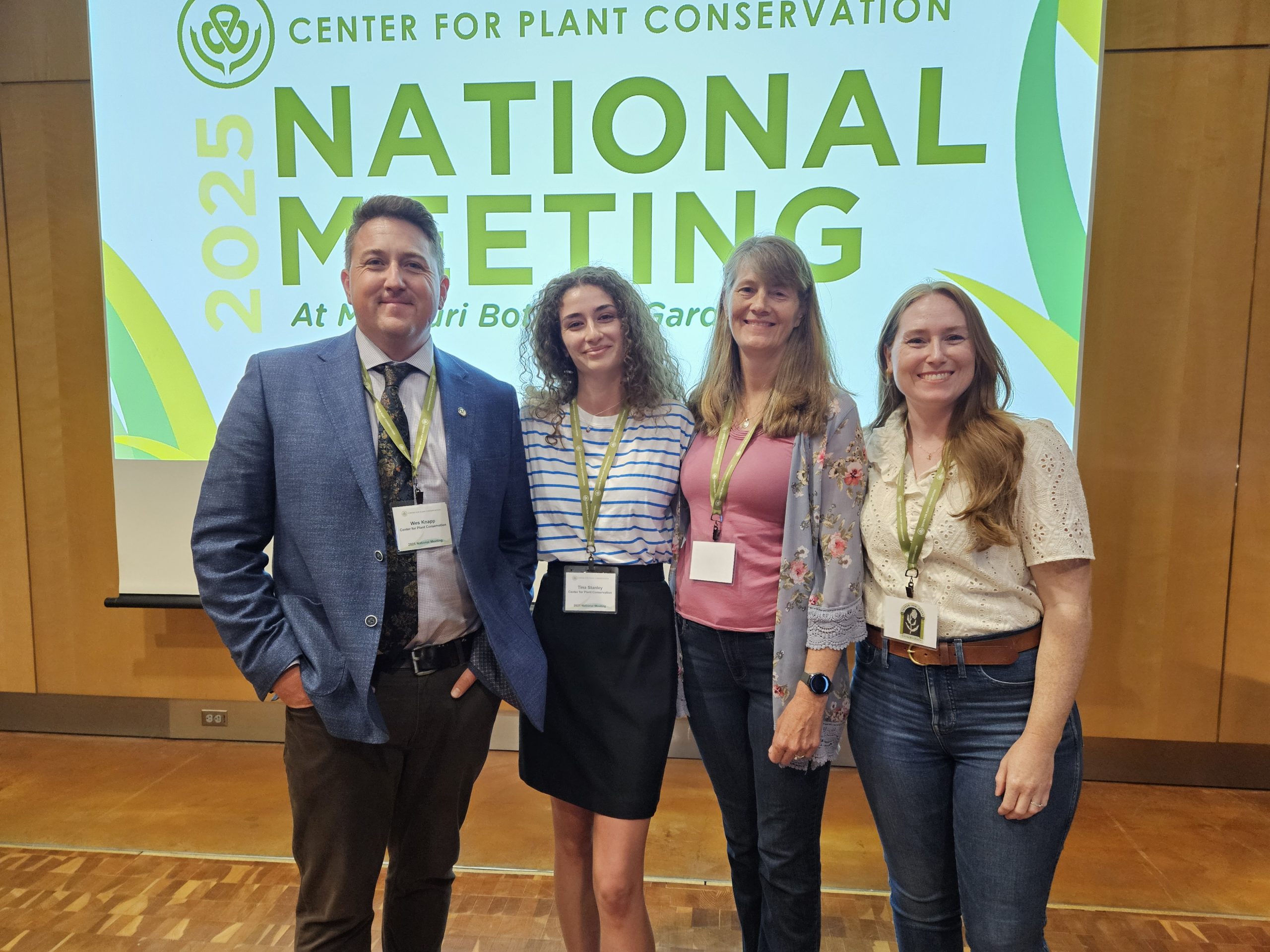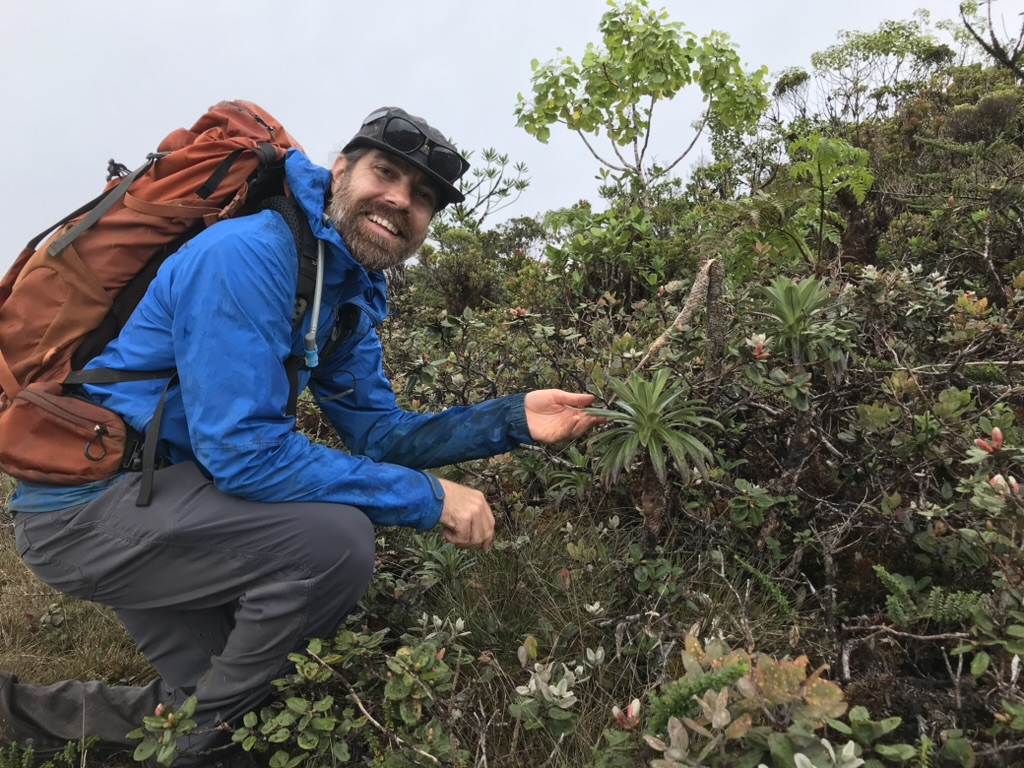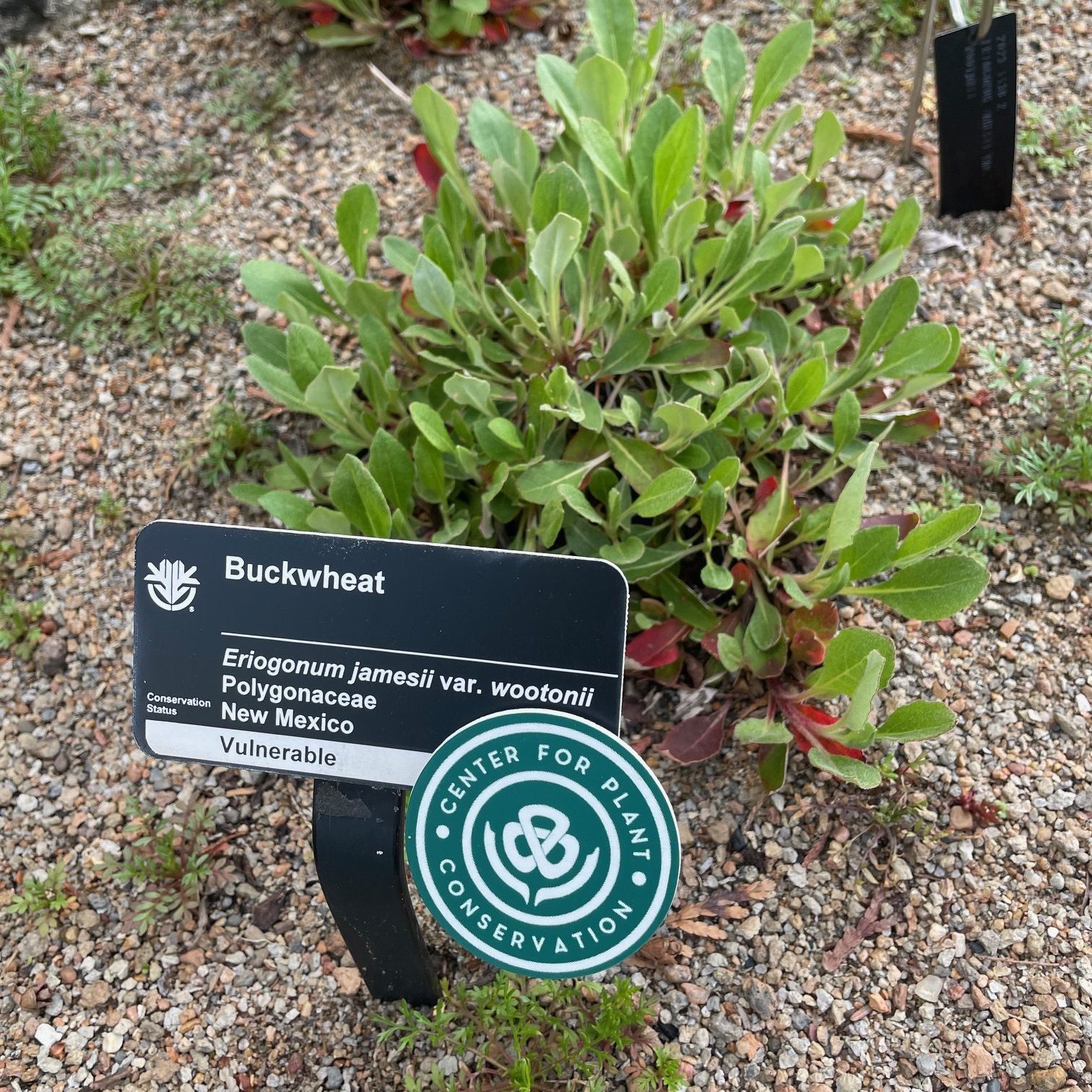Save Plants
CENTER FOR PLANT CONSERVATION
February 2021 Newsletter
In CPC’s early years, our knowledge of seed biology was not what it is today. We assumed that most seeds could live in storage for 100 years. To their credit, our conservation officers have long followed CPC gold standard protocols to ensure that rare plant seeds stay alive in freezing storage for as long as possible. Yet within the last 20 years, we have seen that there is great variation in the lifespan of seeds in storage even when they are properly stored. As living entities, seeds have a lifespan. They do not live forever. Some live a very long time, while others do not. The problem is that we have not tested enough species to know what longevity to expect when we collect seeds of a new rare species.
When CPC participating institutions collected seeds in the mid-2000s from National Park Service lands, one of the benefits of this national effort was seed testing by Dr. Christina Walters at the National Laboratory for Genetic Resources Preservation (NLGRP) in Ft. Collins, CO. She discovered some patterns that spurred further research and elucidated the fact that some seeds are short-lived in storage. For those of us who wish to secure rare plants in the safe, efficient manner of frozen storage, understanding which seeds are long-lived and which are short-lived is critical. To reveal the secrets of seed longevity, CPC Headquarters is spearheading a collaborative research study with our PIs and NLGRP. The work benefits not only from Dr. Walters, but also from the foresight of Fritz Went and Phillip Munz, whose seeds collected in 1947 are part of our study, and from the ever-diligent efforts of our Conservation Champion, Lisa Hill. Read more about this exciting endeavor in this month’s issue of Save Plants.
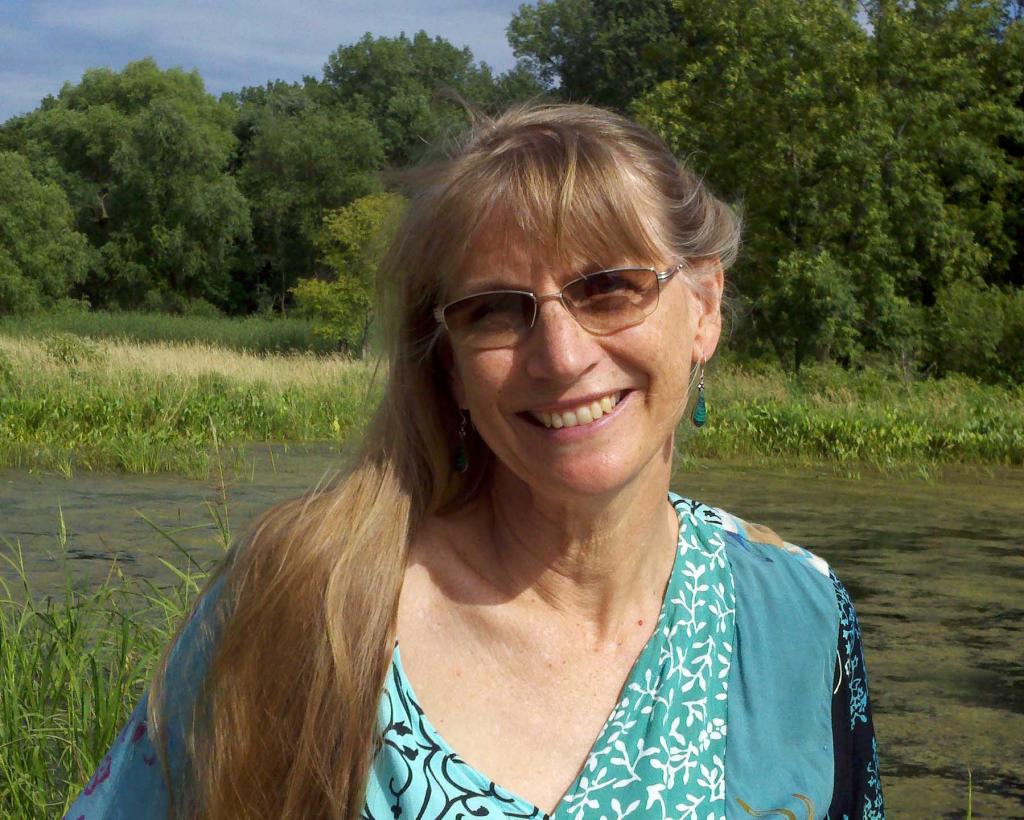
Joyce Maschinski
CPC President & CEOReaping what we’ve sown: Using long-term seed collections for novel seed conservation research
Working with the CPC network over the past five years has opened my eyes to many conservation truths—none more important than seed conservation. The diversity of methods we used to process and store seeds in long-term collections mirrors their remarkable variation in nature, ranging from the dust-like seeds of orchids to five-pound coconuts. “Seeds are not rocks,” says Dr. Chris Walters. Because seeds are alive, they are also dying. The use or replacement of priceless, aging seed collections of rare plants before their often unknown “expiration date” is an urgent task for seed banks. Without an exit strategy, seeds we have so carefully collected and curated do not hold conservation value –they are simply fruit rotting in a vault.
Enter the dedicated conservation officers in the CPC network, who have preserved thousands of rare plant seed collections in frozen storage over the past 40 years. Thanks to their efforts, we are well poised to improve the monitoring of seeds in storage and determine when they might need an exit strategy. Happily, we are now ready to take the next step forward, powered by a three-year, $500,000 National Leadership Grant from the Institute for Museum and Library Services, received in August 2020.

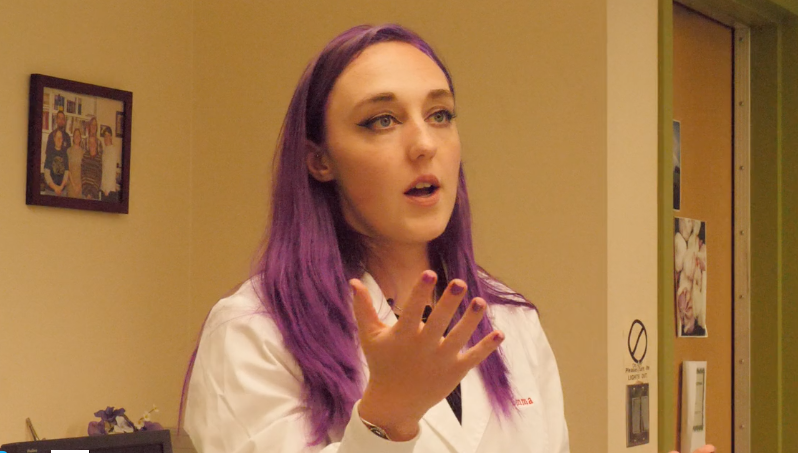
The grant funds research to evaluate RNA integrity as a proxy for seed aging in wild rare plant species. This concept arose on a trip I took with CPC’s CEO Joyce Maschinski to visit Chris Walters and her lab protégé, Lisa Hill, at the USDA-ARS National Laboratory for Genetic Resources Preservation (NLGRP) in Fort Collins, Colorado. The mission was two-pronged: to capture Chris and Lisa on video performing their state-of-the-art seed conservation methods (see here and here), and to plan a proposal for rare plant germination research in the CPC network.
During the visit, Chris described her team’s recent work on RNA integrity in crop species to us. Unlike germination tests, which can only detect seed aging after seeds are already dying, RNA integrity declines linearly with the age of seeds. Chris explained that a calculated RNA integrity number (RIN) can provide information about seed age before seeds die, allowing seed curators to grow out or re-collect seed from rare plant populations before their “expiration date.”
To use RNA integrity as a measure of seed longevity, we will first need to evaluate its efficacy in wild rare plant species. This can be done by comparing RNA integrity and germination success between newly collected seeds and seeds aged 20 years or more in frozen storage. To acquire the test material, we would need our Participating Institutions (PIs) to review populations of seeds currently held in frozen collections and allow us to use a small quantity of original frozen seed for research. However, we weren’t sure that we could get the Participating Institutions on board. Would the conservation officers in our network view re-collecting seeds from populations already represented as a worthwhile activity? After all, so many populations—and entire species—have never been collected at all and need their attention.
-

Berberis nevinii is among the species nominated by California Botanic Garden for seed longevity analysis. Photo by Bart O'Brien. -
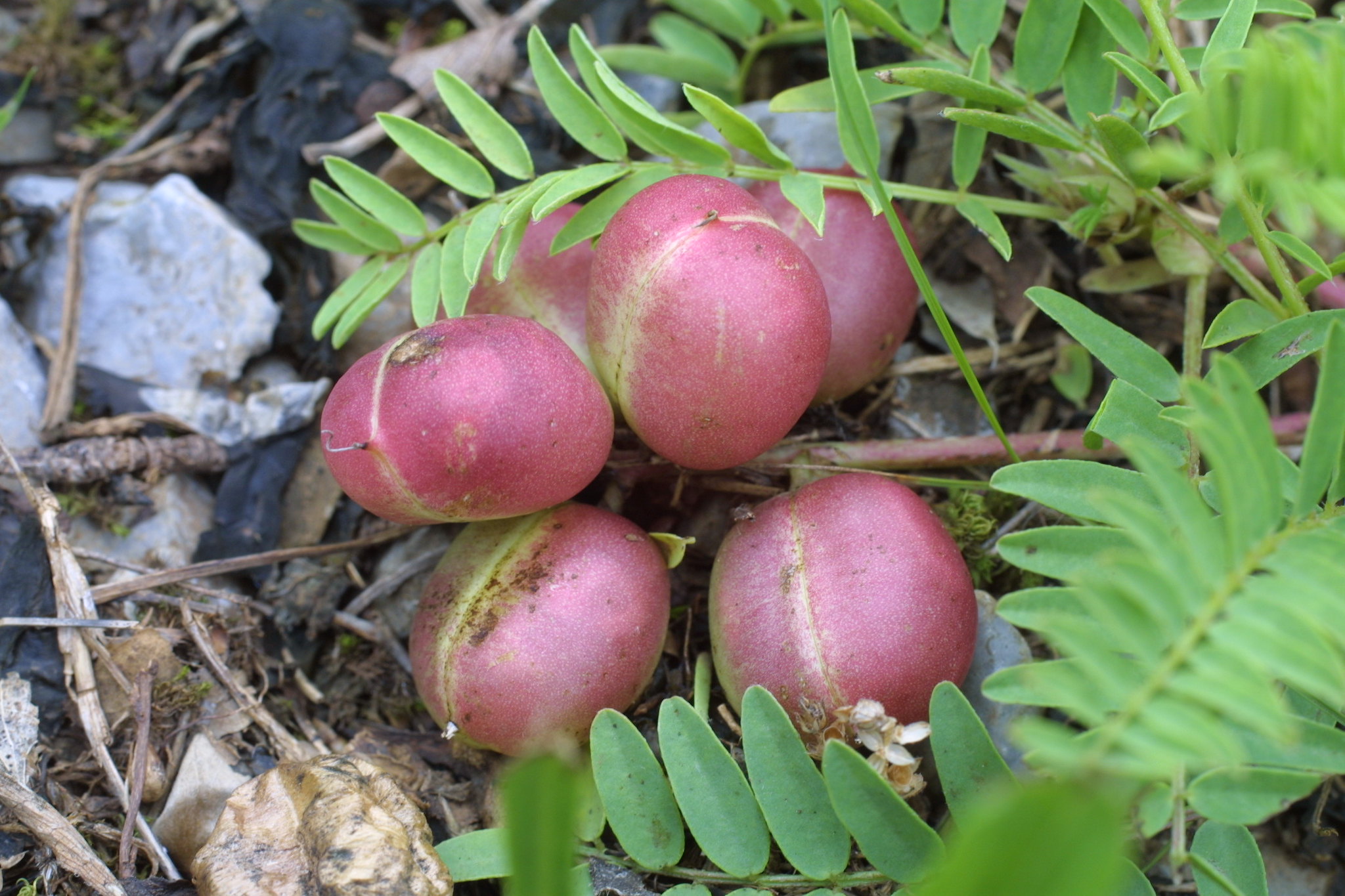
Missouri Botanic Garden will recollect five species for CPC's seed longevity study includes Astragalus bibullatus. Photo by Matthew Albrecht. -
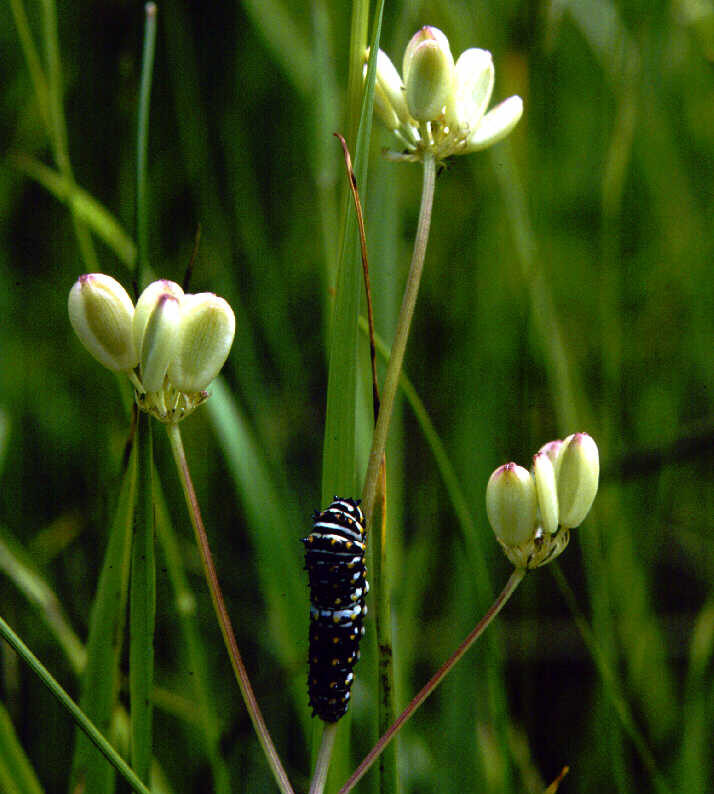
The Institute for Applied Ecology will collect Bradshaw's lomatium from the same population originally collected by Rae Selling Berry Plant ConservationP Program in 1988. The synergy between collecting programs like IAE and long term seed banks like Rae Selling Berry is key to this project. Photo by: Tom Kaye
But the positive response from the CPC network was overwhelming! We received letters of support for the proposal from 15 participating institutions, followed by nominations of over 350 potential plant species from 20 PIs after the grant was funded. Even more impressive than the volume of nominations was the enthusiasm of our network to use the seed collections in their care to further the state of conservation research. I think we all appreciate the opportunity to harvest the fruits of our –or rather our forebears’ -labor.
Now the work begins. This spring, Emma Dorr, a laboratory associate at NLGRP, will conduct RNA assays on common plant species related to the rare species planned for this study. She will determine the feasibility of RNA integrity analysis for a variety of taxonomic groups –which is in question for certain families, most notably grasses. This summer and fall, our PIs will begin making field collections for the 100 rare plant species selected for the study. Our hope is that participating groups will have the opportunity to visit the facilities at NLGRP, see Emma in action processing their samples, and potentially learn how to apply these methods in their own lab.
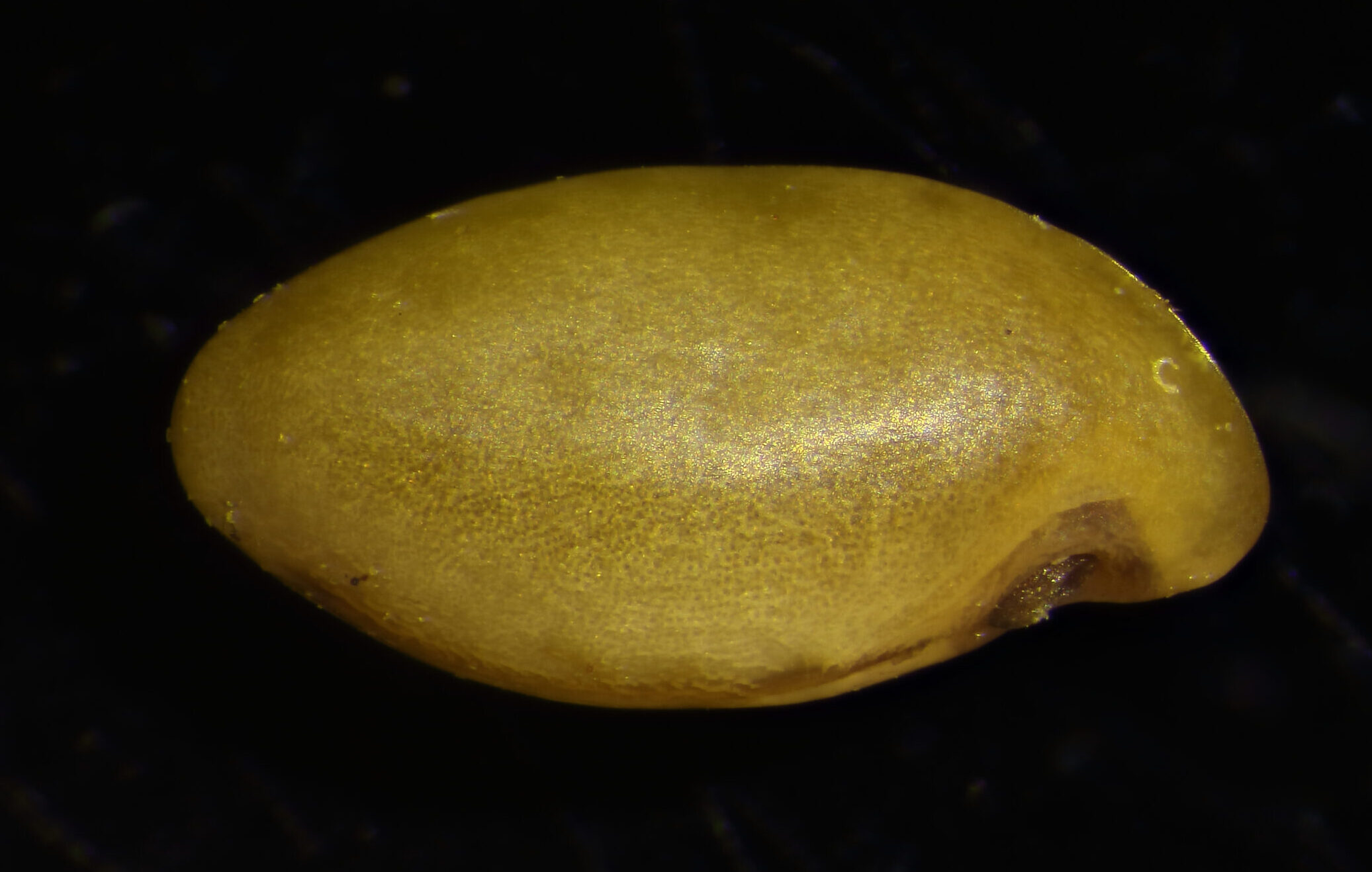
Many questions remain, and we cannot wait to learn more about these precious—and very much alive—seed collections.
A Study for the Ages
Seed banking is promoted as an amazing conservation tool, in part, because of the impressive longevity of stored seed. Stories of successful germination give great hope, including a 2,000-year-old Judean date discovered in an archaeological site and a 30,000-year-old Silene dug out of Siberian permafrost. We know now that such extreme longevity is not a trait of every species. And it wasn’t long ago that the longevity itself was in question.
Claims of seed longevity were largely anecdotal in 1947, when Dr. Frits Went, a botanist at California Institute of Technology, and Dr. Phillip Munz, director of Rancho Santa Ana Botanic Garden (RSABG, and currently called California Botanic Garden), began an ambitious research project designed to last 360 years. Went used seed provided by RSABG staff, including P.C. Everett to conduct one of the first studies examining long-term storage of seeds maintained in partial vacuum. Seeds from 91 native California plants were vacuum-sealed in glass tubes, and sets of 20 tubes in metal cans were stored in a relatively climate-stable room at RSABG. Ideally, one set of seed would be opened after the first year, then with 10 year spacing and finally, every 20 years through 2307 as outlined in Went and Munz’s original paper.
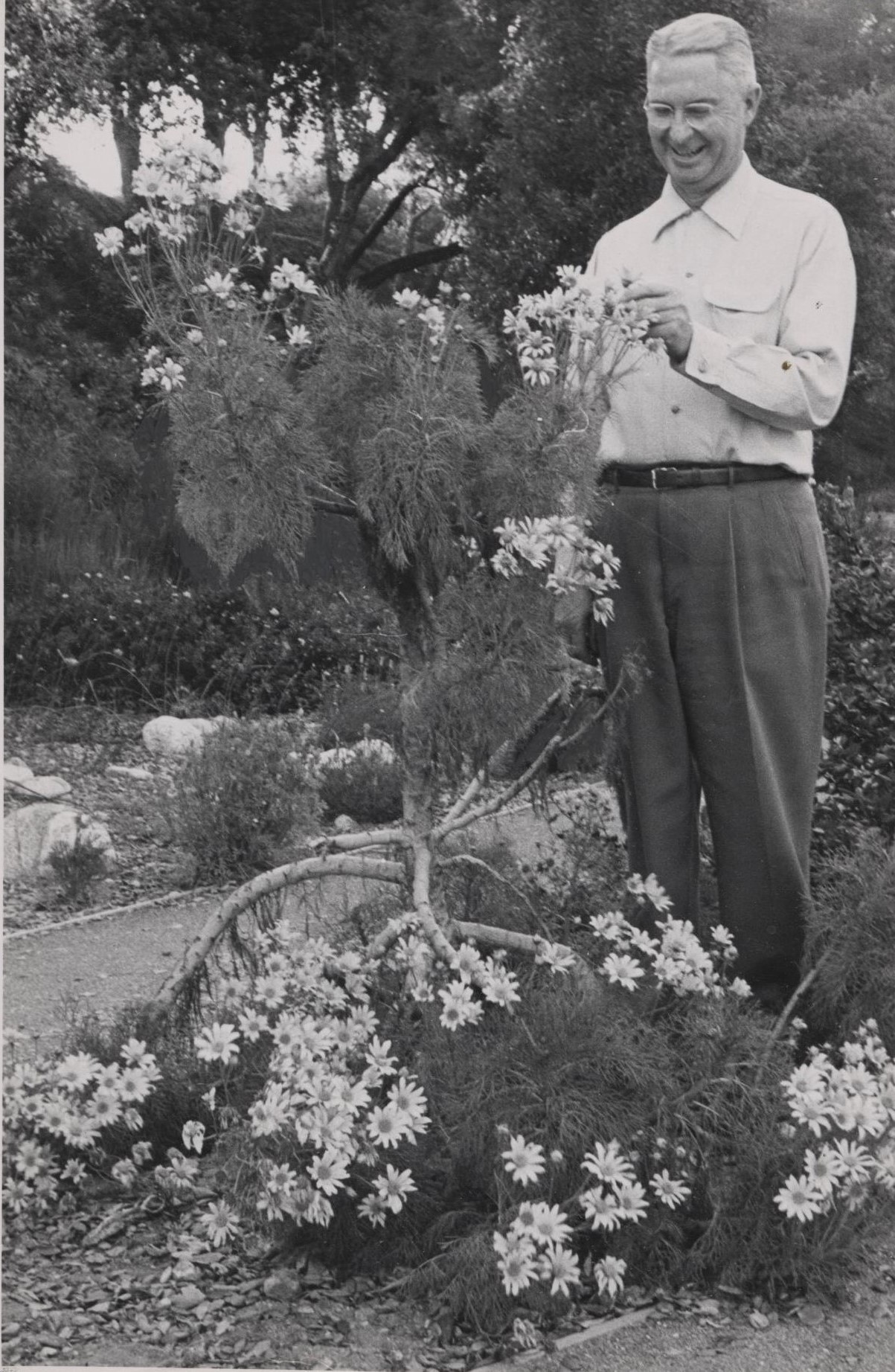
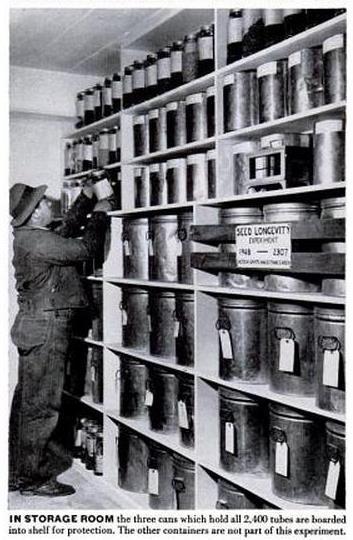
The initial germination tests were conducted in 1948, 1957, and 1967 as planned. When the time came for the 1987 test, the director reported that the seed was missing. Just a few years later, in 1990, the RSABG endangered species coordinator Orlando Mistretta found the seed as he moved the RSABG seed entire collection to a new facility. Following the request of Dr. Went, the seed and the study were transferred to the National Laboratory for Genetic Resources Preservation (NLGRP) in Fort Collins, Colorado. In 1997, University of Northern Colorado master’s student Teri Christensen worked with NLGRP to pry open the containers of 50year-old seed and resume testing. In 2007, Rancho Santa Ana sent their seed bank manager at the time, Evan Meyer, to work with NLGRP staff to examine the seed originating from his garden.
The results have been mixed, yet intriguing.
Seed conserved in the study continues to germinate–unsurprisingly, at a declining rate. Although the seed banking community now follows low humidity, low temperature storage protocols, vacuum storage appears to have been relatively effective, with well over half the species continuing to have germination after 50 years. In general, the results of this study focused on California natives mirror those of other long-term seed experiments focused on economically or culturally important species.
-
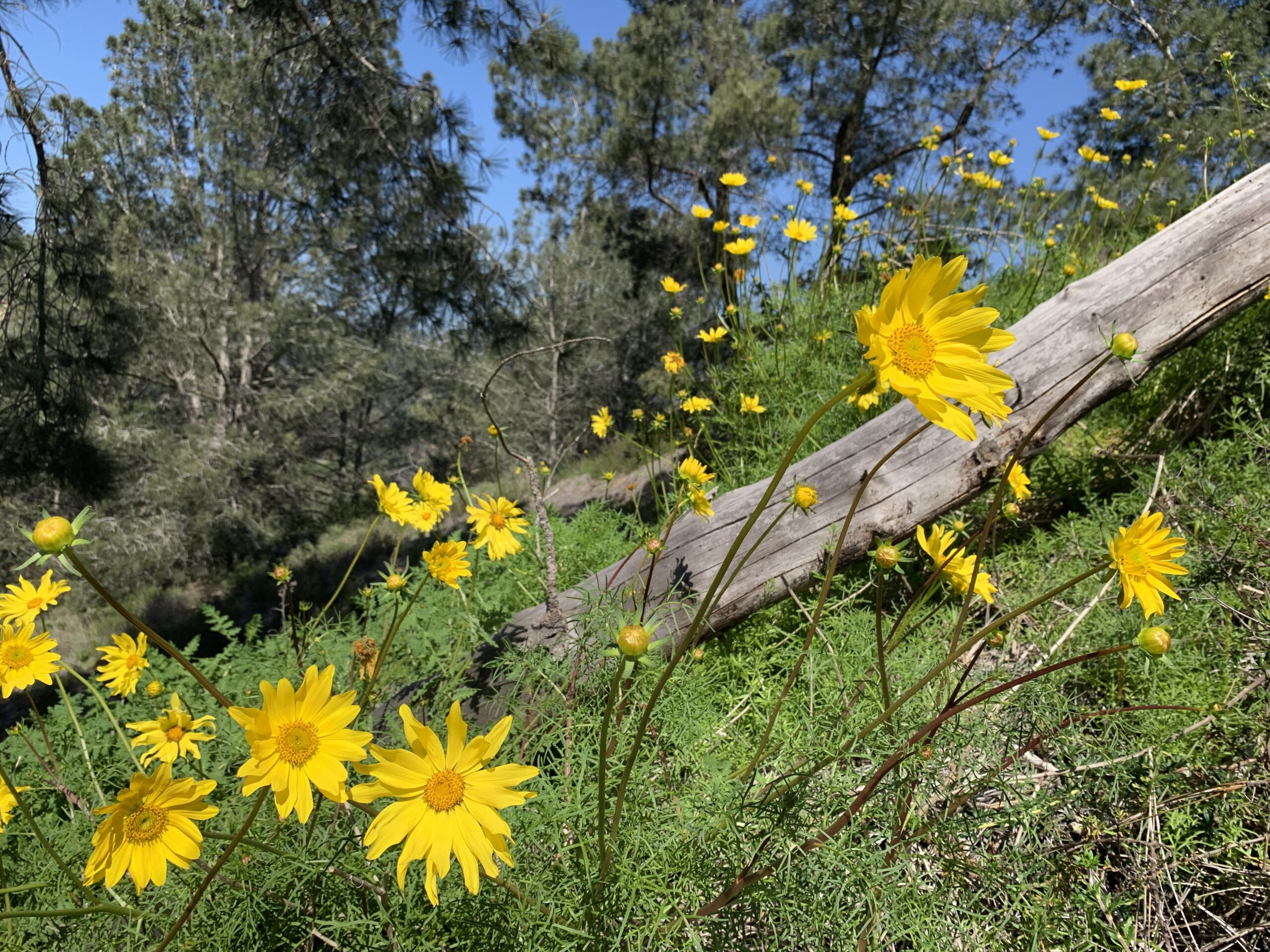
In the 70 years since Rancho Santa Ana Botanic Garden contributed Coreopsis maritima seed, both have undergone name changes! A collection made now would have California Botanic Garden collecting Leptosyne maritima. Photo by Joe Davitt courtesy of San Diego Zoo Wildlife Alliance. -
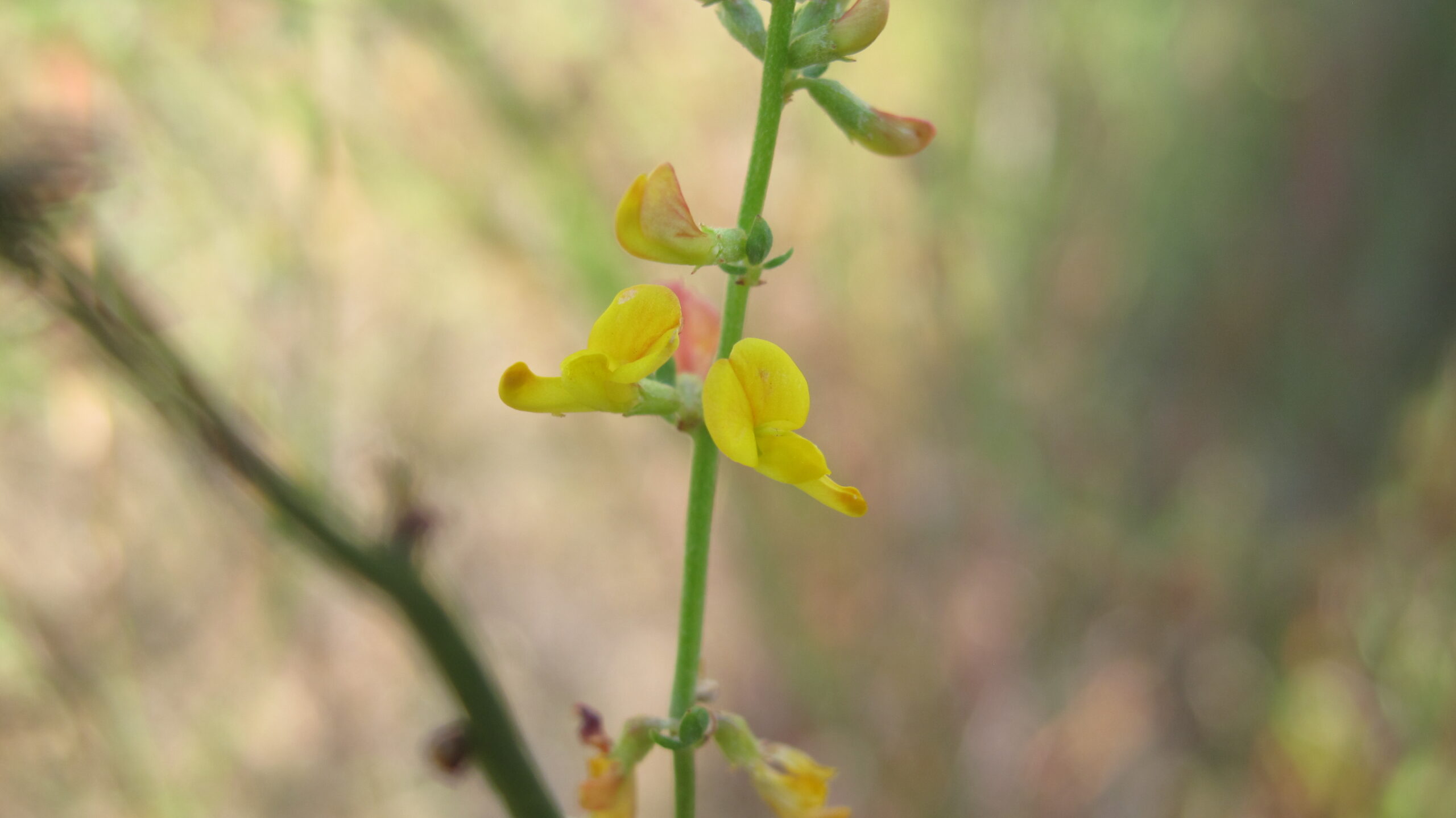
Deer weed (Acmispon glaber) seed collected for the study has had low germination across all tests - possibly pointing to seed quality or dormancy issues. Photo courtesy of San Diego Zoo Wildlife Alliance. -
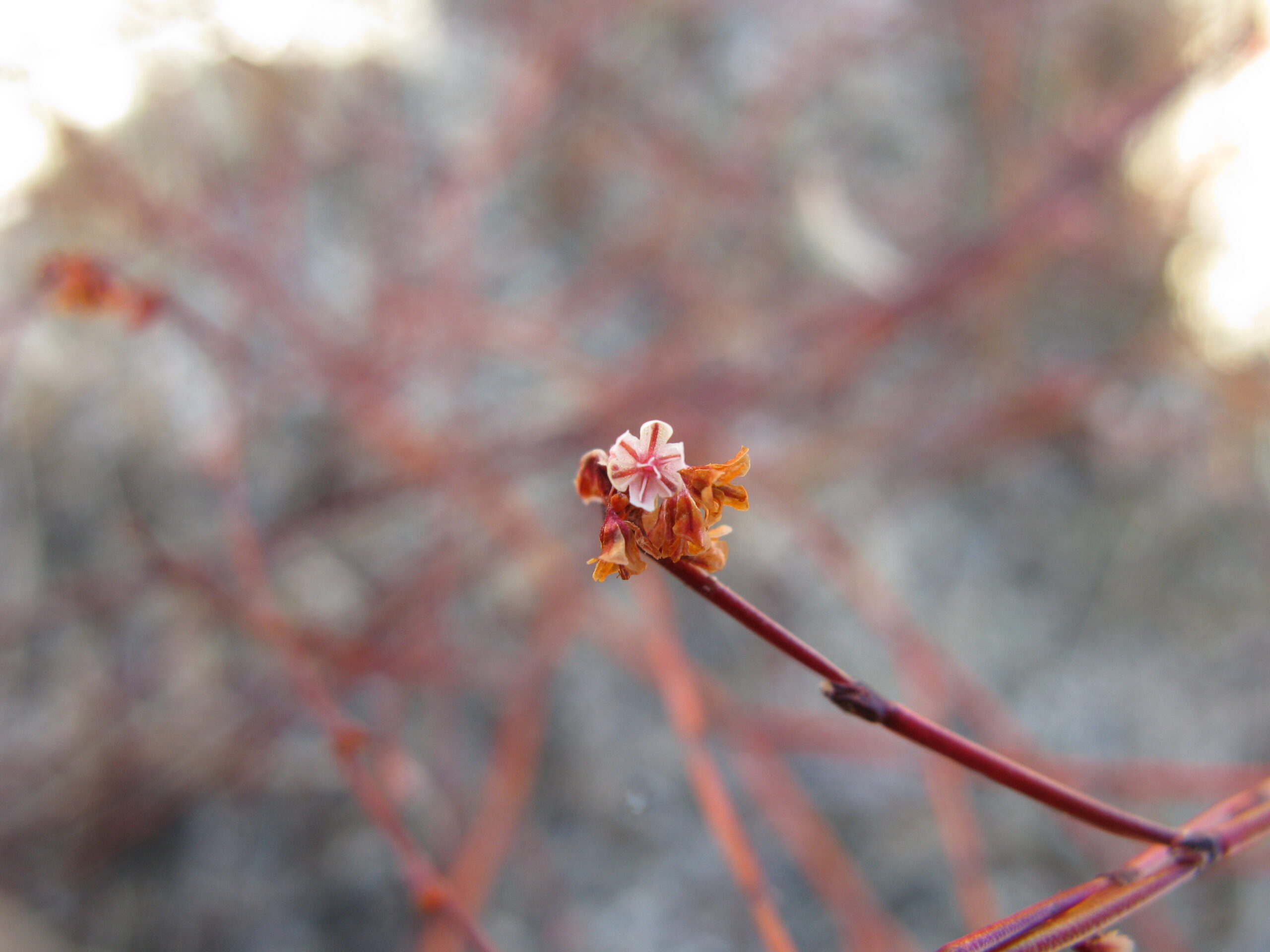
Most of the 91 species were annuals or other herbaceous plants, but the study also included a few shrubs, such as California buckwheat (Eriogonum fasciulatum). Photo courtesy of San Diego Zoo Wildlife Alliance.
Went’s experiment included 91 species from several families and habitat types, allowing for some analyses of basic traits that could influence seed longevity or germination issues such as dormancy. The primrose family (Onagracea) retained higher germination than the sunflower family (Asteraceae). Woodland seeds flourished when compared to desert species. Building on this and similar studies, we understand that traits, taxonomy, and habitats should also be examined when asking questions about seed longevity.
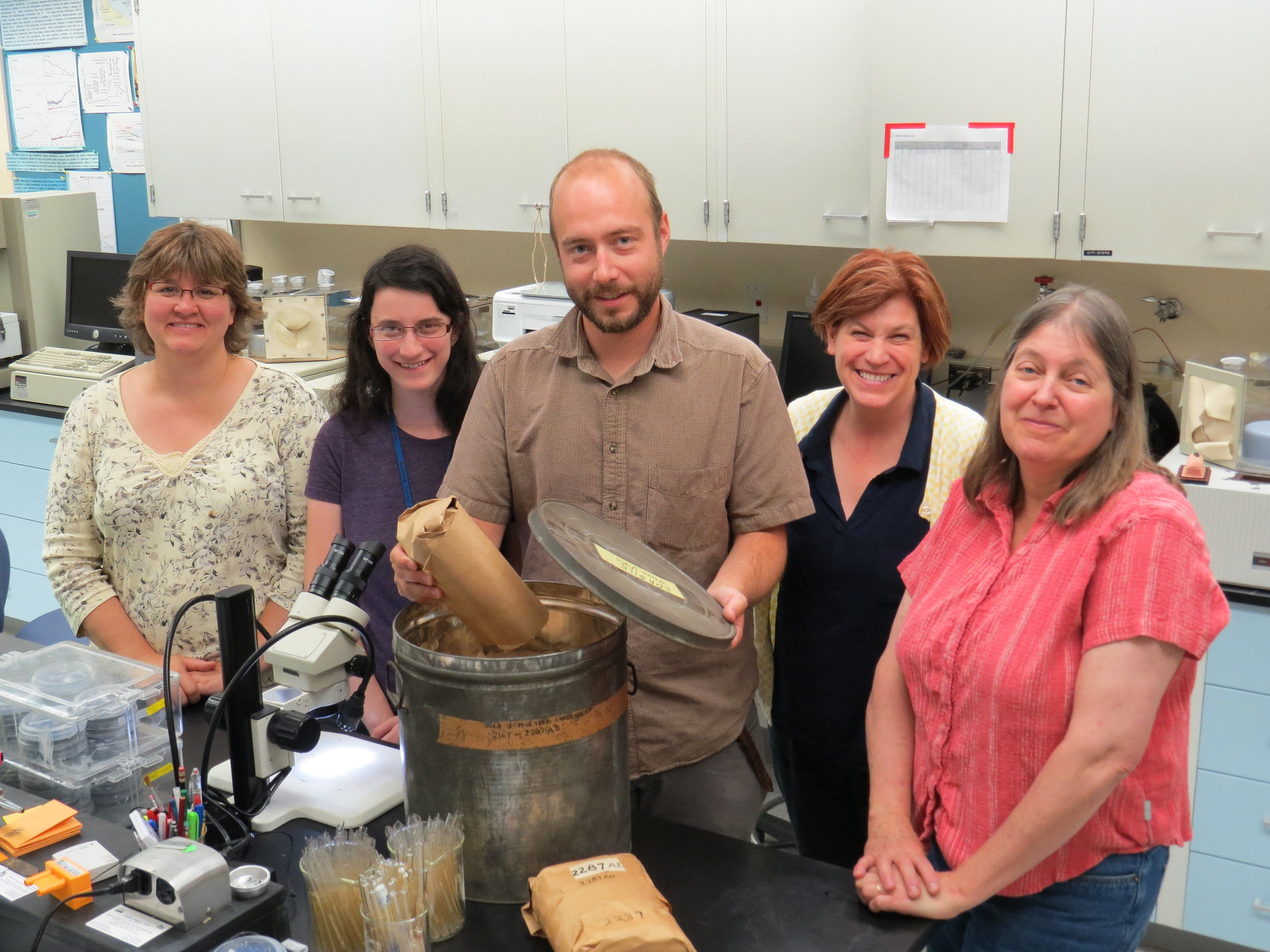
Lisa Hill
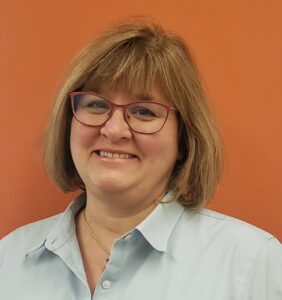
In the Biophysics Lab at the National Center for Genetic Resources Preservation, you may see Lisa Hill peering into a compound microscope, delicately extracting the embryo from an acorn. When you try this task yourself, you realize what amazing dexterity and patience is involved to accomplish this feat! Lisa’s dedication to seeds – tiny and large – has led to many important discoveries about the best way to germinate and store seeds of various species. For many years, she has been the shepherd of CPC’s rare seed collections. They could not be in better hands! We are grateful to our Conservation Champion, Lisa Hill, for her part in helping us Save Plants!
When did you first fall in love with plants?
My love of plants is still evolving. I did not grow up in an outdoorsy family. We “camped” with the neighbors at any Holiday Inn with a nice outdoor pool. My initial appreciation of plants was not in the details of a particular species, but love of a beautiful lush green landscape. I grew up in Peoria, Illinois,and visited the Pacific Northwest every summer. My most vivid memories of plants come from laying in the backseat of the car traveling to swim meets and watching the various shapes and colors of trees along the river bank or the mesmerizing, repetitive view of bright green rows of corn against black soil out the side window. My grandmother’s garden in British Columbia produced riots of raspberries and flowers and smelled so earthy. I now appreciate the diversity of plants, not just for their beauty in a landscape, but also their ability to fill so many ecosystems of our world and their complicated and diverse reproductive paths.
What was your path to joining the lab at NLGRP?
I started working at NLGRP as an undergraduate student helping a postdoctoral researcher who was investigating lipid peroxidation in seeds. It was a lab bench job, so sort of fit in with my undergraduate major in microbiology. The more interesting question is why I stayed at NLGRP. I stayed because of the people that work there. Seeing their passion and dedication to plant genetic resource preservation was inspiring and that passion rubbed off on me. We continue to hire undergraduate students. Some already have a love of plants, we hope to inspire their appreciation of seeds in all.
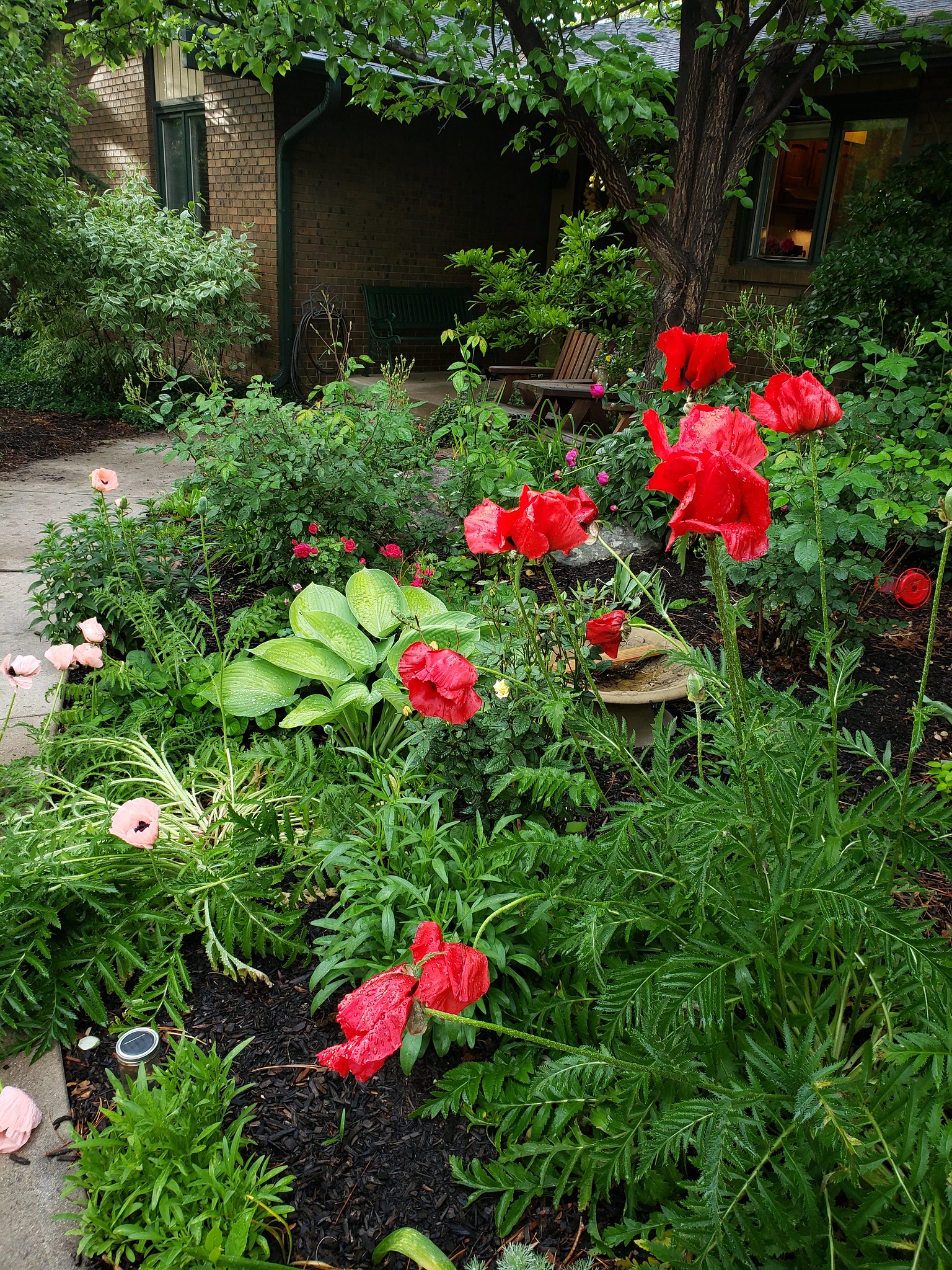
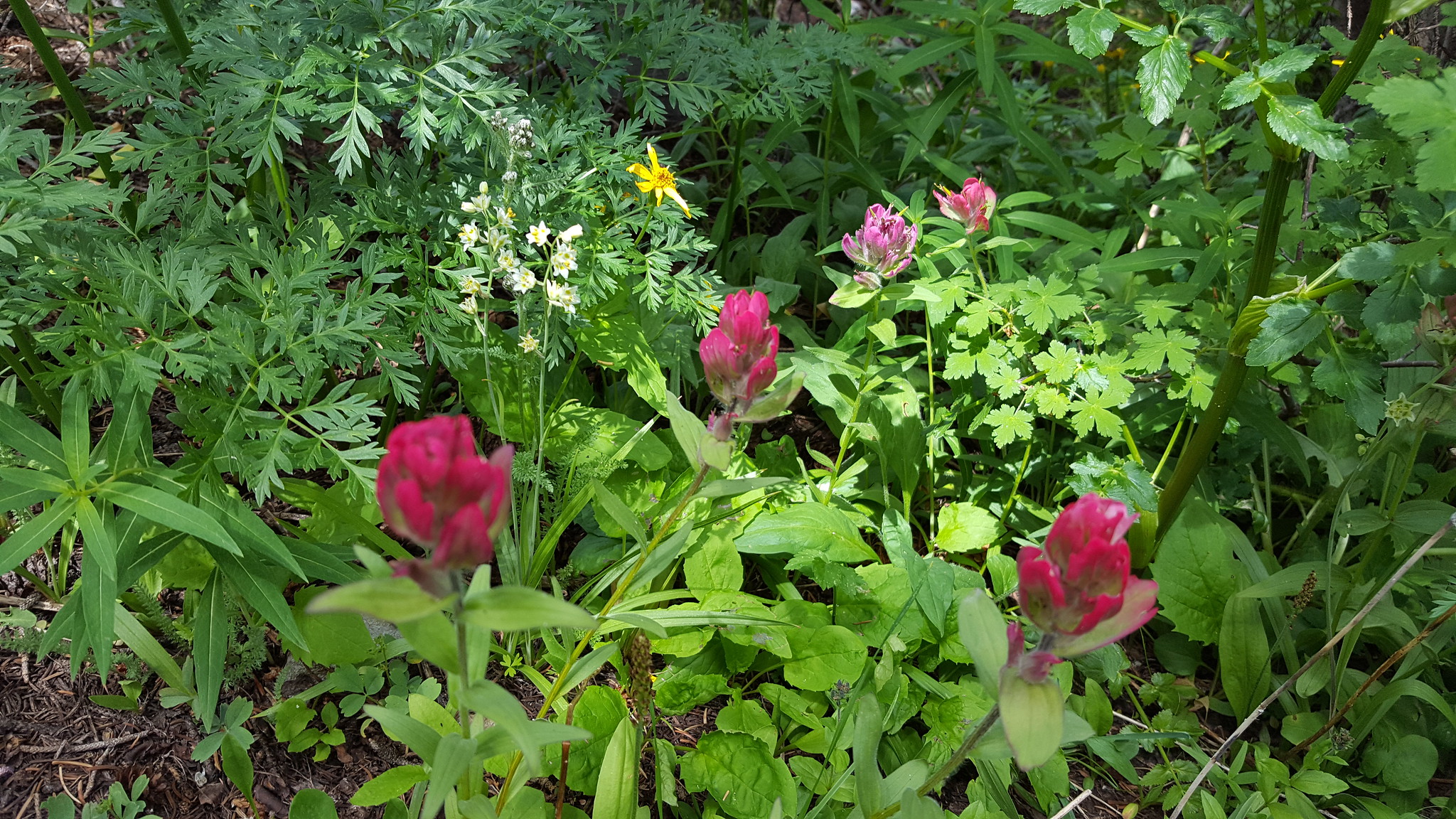
Why do you think it’s important to expand USDA work to more plant species?
NLGRP houses 1.2 million seed accessions representing ~230 families, ~3000 genera and ~15,000 species. Our collection is vast but the taxa that go to NLGRP isn’t really our decision. Our responsibility is to ensure it’s safe while here. We carry out research on diverse plant groups to unlock the secrets of how they survive in storage and how we can revive them and grow them when it’s time to pull them out of storage.Our dedicated partners have the responsibility of ensuring that wild plants are conserved ex situ. That’s why this is a great partnership –we learn from each other and are able to leverage resources for each other.
What are the main differences in working with wild species and crop species?
Working with wild species is much more difficult than working with seeds from cultivated crop species. Seed sample size from wild species are typically small. Seed quality is less consistent. The germination requirements are often not known. Dormancy is a greater challenge to overcome. Our partners who collect and manage wild species collections often separate collections based on maternal plants, effectively making a small accession even smaller. When researching seed physiology with wild species, particularly rare or endangered species, we try to gather the most amount of information (and use non-invasive tests) from the fewest number of seeds.
-
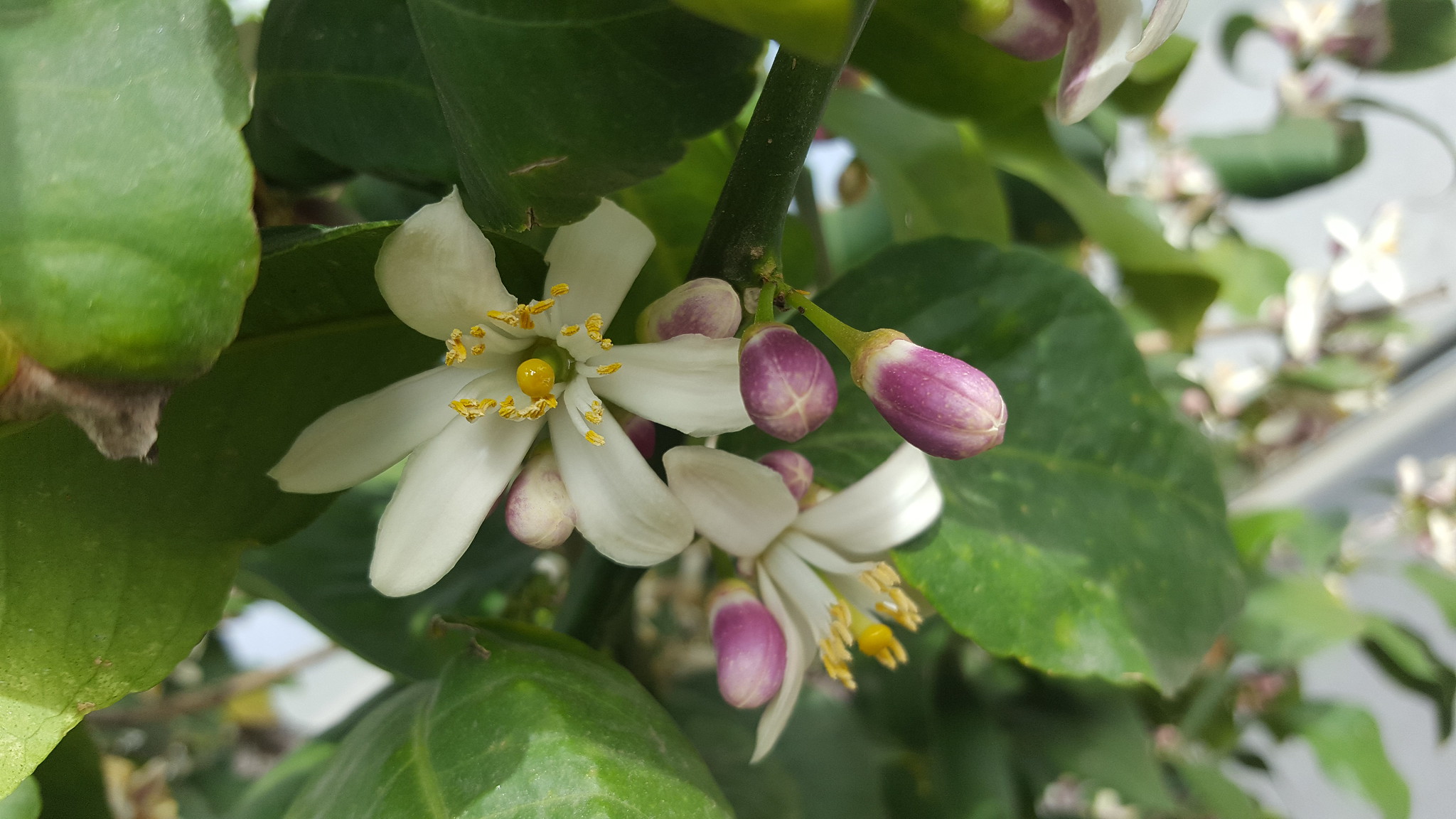
Most of Lisa's work is agriculturally focused, as when she went to collect pollen from citrus flowers in Riverside, CA, at the USDA's National Clonal Germplasm Repository for Citrus. Photo courtesy of Lisa Hill. -
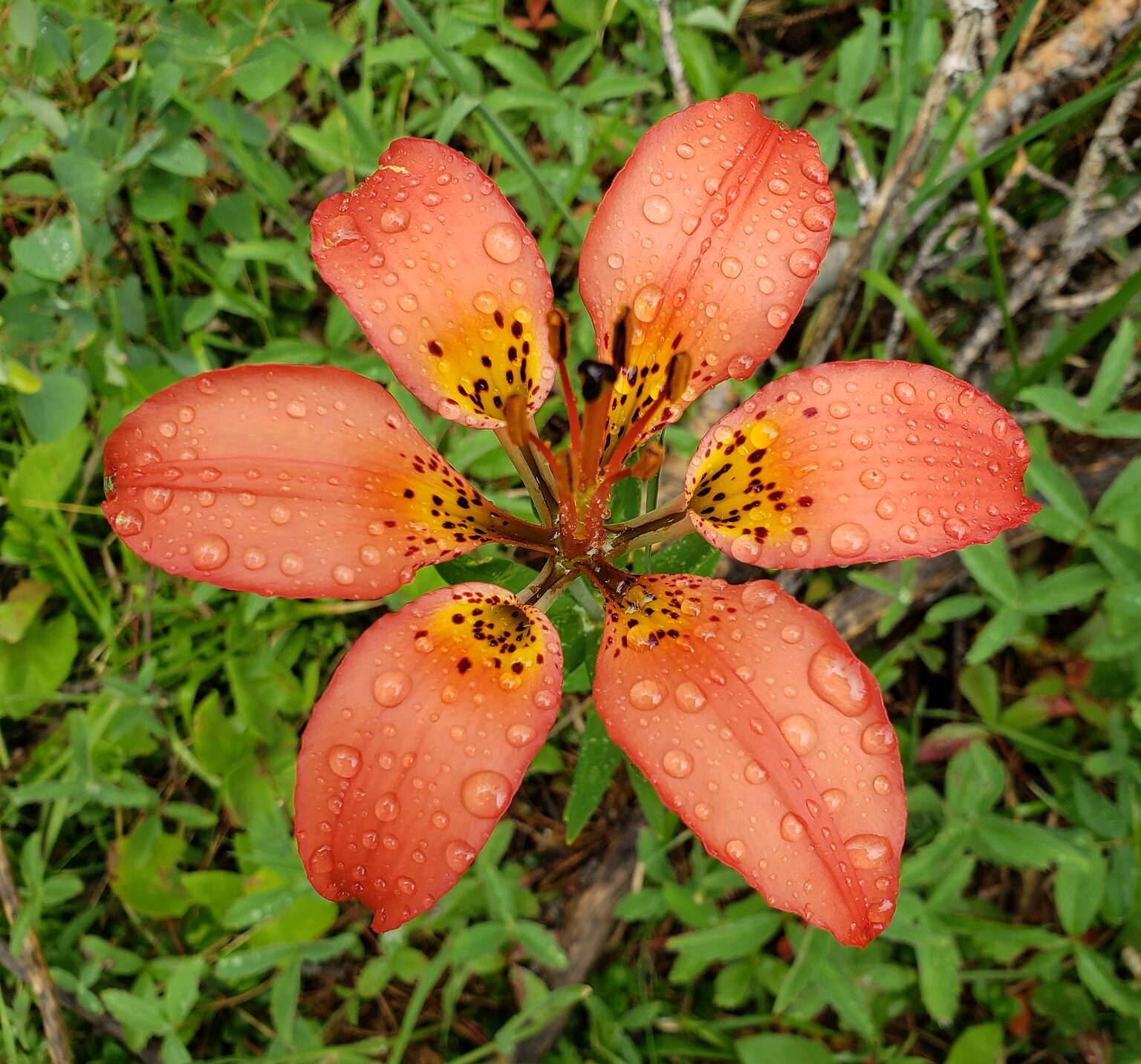
Lisa enjoyed the blooms of three red lilies (Lilium philadelphicum) at her cabin this year. Photo courtesy of Lisa Hill. -
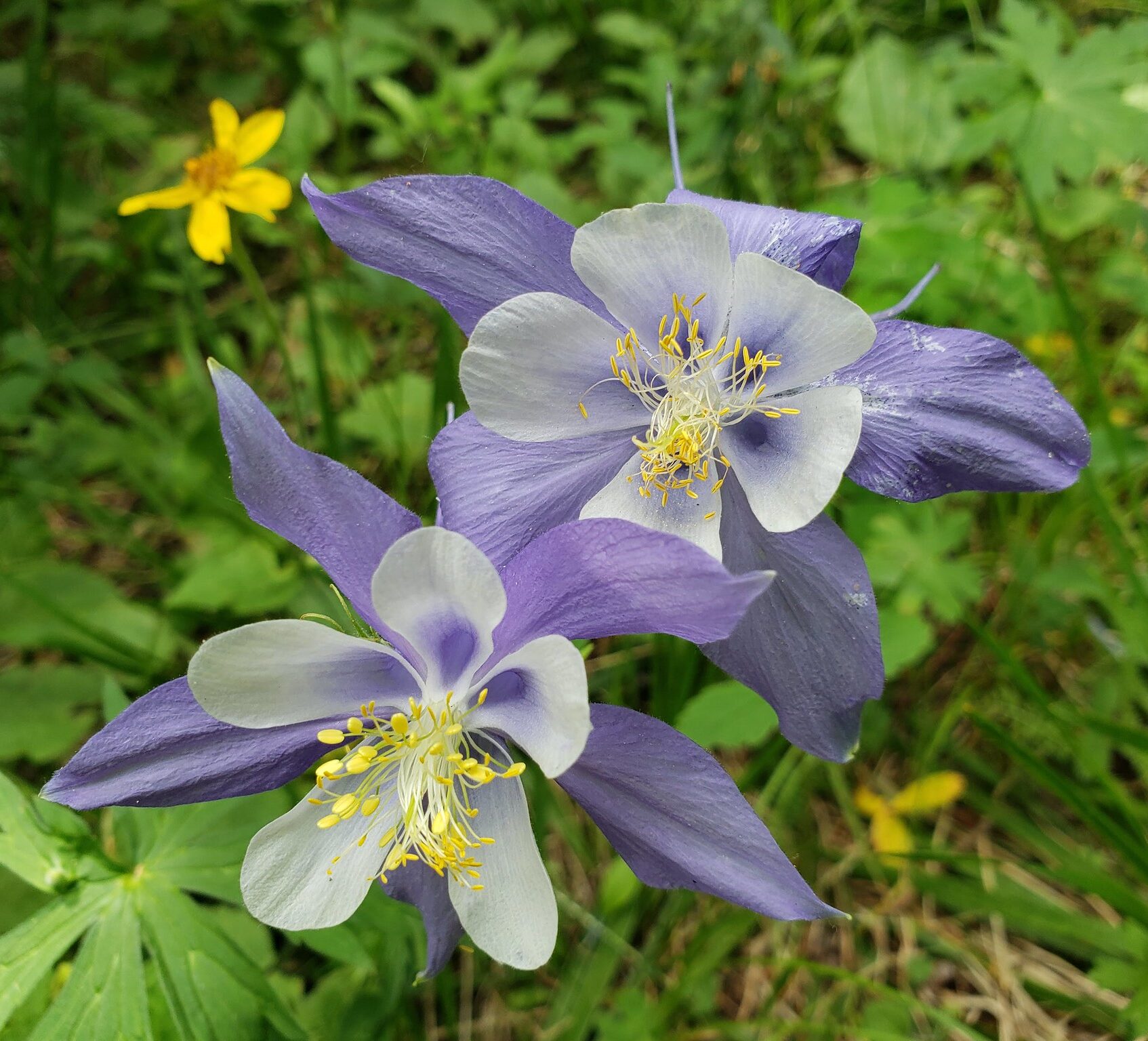
Colorado Blue Columbine (Aquilegia coerulea) at the cabin. Photo courtesy of Lisa Hill.
What are the greatest challenges you face in your work?
My answer will sound familiar to many. The greatest challenge is that the job is big and time is limited. We are currently working on 400 guar (a type of pea), 5000 small grains, and more than 400 Seeds of Success accessions-and that’s just February! Another big challenge is accurately assessing viability when the germination requirements are unknown, not optimized, or take months to years to achieve maximum germination.
What about working with plants has surprised you?
There have been several surprises. The species level of diversity housed here at NLGRP is surprising. The number “15,000 species” can lose it’s impact in a statistic on paper. The actuality of receiving a “new to us” species every single week makes a real imprint. I have enjoyed working with a range of propagules, from seeds and fern spores to tree pollen, and with material collected in city parks, wildlife areas, and nurseries in Fort Collins. We have used that material as model systems to improve knowledge about longevity, best storage practices, and investigating seed development. I am more excited and less surprised when a really old seed germinates. I am most appreciative and encouraged by our partners that bring so much knowledge and passion to their role in plant conservation.
What excites you about up coming seed research or new applications?
We just purchased a Videometer and training starts this week! It takes multispectral images with 19 different wavelengths. At a minimum, we will use it as an auto sampler to quickly count the number of seeds for a germination assay. Our greater plan and focus will be to investigate physical properties of seeds and relate that to overall quality -and maybe even viability. This instrumentation is used commercially at seed companies, usually specializing in a few major crops. NLGRP may be the first to apply this technology to vast diversity of species. The ultimate goal is to gain more information about seed quality with out using up any of the collection.
As Seen on Rare Plant Academy
During CPC’s 2020 National Meeting, Alex Seglias of Denver Botanic Garden presented her work examining the seed longevity of alpine species from the Colorado Rocky Mountains. To evaluate how well four species would survive in traditional seed banking conditions, Alex used accelerated aging techniques followed by germination tests. As with Alpine species studied in Italy and Australia, Alex found significant effects of the aging treatment on germination time and rates, indicating that these species would be short-lived in cold storage. Her study points to the importance of assessing environmental and evolutionary factors that may reduce seed longevity in storage, rather than assuming that all species survive for decades in seed banks.
Get Updates
Get the latest news and conservation highlights from the CPC network by signing up for our newsletters.
Sign Up Today!Employment Opportunities
POSITION DESCRIPTIONTitle: Managing Ecologist, WoodlandsReports to: Director of Restoration EcologyRegular or Seasonal: RegularFull-time or Part-time: Full-timeSupervises: staff, students, interns, volunteersAbout us: The Chicago Botanic Garden’s Plant Science and Conservation program is a global leader in plant-based research, education, and engagement to sustain and enrich life. The Garden’s mission is grounded in the belief that caring for gardens and natural areas is fundamentally important to the well-being of everyone. We strive to make the Garden and all its programs available and accessible to people of all ages, backgrounds and abilities. We value diversity in all its forms and at every level of our organization – board, staff, volunteers, and vendors. Through the diversity of backgrounds, perspectives and experience, the Garden is more effectively able to create extraordinary and welcoming experiences for our increasingly diverse audiences. We are committed to ensuring a sense of belonging to every individual we encounter, regardless of age, race, gender, ethnicity, religion, sexual orientation, physical ability, intellectual ability, or economic status.About McDonald Woods: Since 1988, ecological restoration in the Garden’s 100-acre McDonald Woods has transformed a formerly-degraded oak woodland into a natural treasure that supports hundreds of plant and animal species, including a dozen rare and endangered species. In 2013 these efforts were recognized with a “Gold Accreditation” from the Chicago Wilderness Excellence in Environmental Restoration Program. Within its 100 acres, McDonald Woods is home to five community types and a startling amount of diversity across trophic levels. In addition to restoring plant species diversity in these habitats, Garden ecologists have collected invaluable data on the diversity of organisms present in them across trophic levels. These surveys have revealed hundreds of species of mammals, birds, plants, and arthropods, with several species never documented before in the state of Illinois and some species new to science. Learn more about Jim Steffen, who is retiring after leading these efforts in McDonald Woods for more than 30 years, and his more recent work documenting moth species in McDonald Woods (more than 600 taxa and counting) in this Chicago Tribune article.Position Overview: The Managing Ecologist, Woodlands is responsible for leading ecological restoration, management, and related research activities in the Garden’s woodland habitats, including McDonald Woods, the Garden’s 100 acre remnant oak woodland. Work with the Garden’s natural areas team of ecologists to collaboratively manage natural areas across the Garden. Working with staff in the Garden’s Negaunee Institute for Plant Conservation Science and Action, as well as staff and programs throughout the Garden, the Woodland Ecologist will also help to develop and support related onsite research, learning, and community engagement activities. This includes ensuring a welcoming and inclusive environment while supervising and mentoring a diverse team of staff, students, and volunteers. Through strategic partnerships, including with the Forest Preserves of Cook County, on whose land the Garden is based, the Woodland Ecologist will also help grow the Garden’s role as a leader in efforts to restore, manage, understand, and support sustainable use of woodlands in the region.Duties and Responsibilities1. MANAGEMENT: Lead efforts to maintain and continue to enhance and adapt management and restoration activities in more than 100 acres of remnant and restored woodlands at the Garden to support species diversity, ecological integrity, and staff and visitor safety. Includes active management of invasive species (including with the use of herbicides), conducting prescribed burns, collecting, seeding, and planting native species, removing or overseeing the removal of dead standing trees, trail maintenance, deer fence maintenance, maintaining appearance (litter collection, etc.) associated with woodland roadways and boundaries, and related activities.2. MONITORING: Ensure continued collection and management of long-term data on plant and wildlife species in the Garden’s woodland habitats to measure restoration success and management outcomes). Will also work with research staff to develop and implement a plan to synthesize and use these data to address priority management questions and inform future data collection and management efforts.3. RESEARCH: Develop a collaborative research agenda with staff ecologists, Garden scientists, undergraduate and graduate students in the Plant Biology and Conservation program, and outside collaborators in support of woodland restoration ecology and management at the Garden and regionally.4. LEADERSHIP: Ensure a welcoming and inclusive environment. Directly supervise and mentor Woodland Restoration Technician and co-supervise (with Prairie and River Ecologist) the Assistant Ecologist – Natural Areas. Includes recruitment, payroll/time and effort reporting, performance reviews, personnel matters, and budget development/tracking for the Woodland program.5. COMMUNICATIONS: Serve as a point of contact for communications (internal and external) regarding the Garden’s woodland program (including McDonald Woods) to ensure accuracy and relevance of all communications.6. PLANNING: Support strategic planning, master site planning, and capital projects relating to the Garden’s woodland program that ensure appropriate and sustainable use. Help to identify and secure funding for priority projects related to the woodland program.7. INTERNAL COLLABORATION: Actively collaborate with other Garden departments, including:1. Learning/Engagement and Interpretation to develop and implement programs, classes, and interpretation that help diverse audiences learn about and experience the Garden’s woodlands.2. Horticulture and Collections to manage Garden grounds, particularly related to management of invasive species. This includes communicating about any new species invading natural areas, and sharing expertise related to managing invasive species.3. Volunteer Services to engage volunteers in work related to the woodland program.8. EXTERNAL PARTNERSHIPS: Forge and support strategic external partnerships and engage with community partners to advance regional efforts to:1. Research, manage, and restore woodlands, with a particular emphasis on supporting understory plant species diversity.2. Train and employ the next generation of diverse land managers and researchers, specifically and intentionally inclusive of individuals from groups historically excluded from conservation and land management.3. Make woodlands accessible while supporting their sustainable use by diverse audiences.Qualifications: Minimum three years hands-on experience in natural areas restoration, management, monitoring, and prescribed burning. Experience in, or desire to learn, use of chainsaws, ropes, and mechanical devises for safely felling mature, dead or hazard trees. Bachelor degree required, MS degree in a related field preferred. Experience managing and mentoring staff, as well as volunteers and/or students. Commitment to fostering a diverse, equitable, and inclusive environment. Familiarity with plants of the Chicago region preferred. Ability to key plant species out using a dichotomous key. Familiarity with Midwestern invasive plant species and management approaches. Possess or willing to obtain an Illinois pesticide applicator license and prescribed burning certifications (including Chicago Wilderness Midwest Ecological Prescription Burn Training and State of Illinois Prescribed Burn Manager). Mechanical ability to use and do minimum equipment maintenance on tools such as chainsaws, brush cutters, string trimmers, and leaf blowers.Physical Demands: Frequent, standing, walking, bending, listening, speaking, lifting, pushing, including outdoors during inclement weather. Must be able to lift and carry 50 lbs. Licensed driver insurable by the Society.To Apply: Please go to https://www.chicagobotanic.org/jobs to apply. In addition to the Garden application materials, please submit a resume as well as contact information for three references. All applicants should also complete this application information(https://forms.gle/qgnhK8ZrT9sGAZ666), including answering these four questions: 1. Describe what you would consider restoration success in a northern Illinois woodland, and how you would measure this success over time. 2: Describe a natural areas management challenge you’ve been faced with, how you approached it, your rationale for that approach, and what you learned from the experience. 3: Describe a challenge you’ve been faced with when leading or working as part of a team, how you approached it, and what you learned from the experience. NOTE: This can include any work you have done while leading a team, or as a member of a team, and does not have to be related to your natural areas management experience. 4: Describe what diversity, equity, and inclusion mean to you. Feel free to give any examples of what role it has played in your experiences. Review of applications begins March 1, 2021. Contact Andrea Kramer at akramer@chicagobotanic.org with questions.Why Apply? Come work in a setting that is like no other as you support our mission: We cultivate the power of plants to sustain and enrich life. Take the first step toward being one of the employees who make the Garden one of the treasures of the Forest Preserves of Cook County. Apply today.Please note that applicants who do not meet the required qualifications will not be considered.We are an Equal Opportunity Employer and do not discriminate against any employee or applicant for employment because of race, color, sex, age, national origin, religion, sexual orientation, gender identity, status as a veteran, and basis of disability or any other federal, state or local protected class.Disclaimer: The above statements are intended to describe the general nature and level of work being performed by people assigned to this classification. They are not intended to be an exhaustive list of all responsibilities and qualifications required of personnel so classified.In accordance with Title IX of the Education Amendments Act of 1972, Chicago Botanic Garden does not discriminate on the basis of sex in its programs or activities, including in employment or admissions. Please call (847) 835-8264 to contact our Title IX Coordinator should you have questions or concerns.
*Deadline: March 1, 2021*Overview: Full-time, Permanent*Position: Nursery Manager*Location: Yerington, NV*Job Description: Walker Basin Conservancy (WBC) is recruiting a Nursery Manager to join our team. The Nursery Manager leads, manages, and advances the Nursery Program and oversees all nursery operations, including, but not limited to, seed and plant management; personnel recruitment and supervision; funding acquisition; seed and plant sales; and outreach. In conjunction with the Field Operations Manager and Maintenance Coordinator, the Nursery Manager will maintain and repair Nursery Program facilities, equipment, and vehicles. In addition, the Nursery Manager co-manages the Native Seed Initiative, developing and managing grass, forb and shrub seed production and management in the field, and assists, where appropriate, with the Stewardship Program.*Compensation: $45,000 – $65,000 depending on experience and qualifications. Employee benefits package with employer paid health, dental, vision and life insurance plans for employee, as well as retirement 403(b) plan.*See the full announcement for more details and to apply: https://www.walkerbasin.org/join-our-team
Job Title/Position: Wildlife Biologist 2/00099776
Location: Social Circle, Georgia
Job Responsibilities: We are seeking a Botanist with strong field taxonomy skills to serve in a Wildlife Biologist 2 position for the Wildlife Conservation Section. This Wildlife Biologist 2 will work with a team of botanists on conservation of rare plant species and natural communities identified as a priority in Georgia’s State Wildlife Action Plan. Responsibilities include coordination of conservation actions and population safeguarding for priority rare plant species; design and implementation of surveys and monitoring protocols; data analysis, reporting, and results communication for state and federally funded grants; and increasing collaboration with internal and external partners.
The Wildlife Biologist 2 will also assist the Botany team with surveys for priority rare plant species and natural communities; outreach and technical support to landowners, conservation partners, and the general public; review of projects that may impact rare plants and habitats; species status assessment; and land management planning. They will participate in rare plant habitat restoration using prescribed fire and invasive species management.
Effective written and verbal communication and strong organizational skills are required to meet the demand for information on Georgia’s diverse rare plants and habitats. Coordination with partners, especially the Georgia Plant Conservation Alliance, is critical.
Minimum Qualifications: Master’s degree in Biology or a related field from an accredited college or university OR Bachelor’s degree in Biology or a related field from an accredited college or university AND one year of related experience OR one year of experience required at the lower level Wildlife Biologist 1 (NRP060) or position equivalent
Preferred Qualifications: Preference will be given to applicants with:
1. Demonstrated plant taxonomy skills and familiarity with the flora and habitats of the Southeastern U.S.
2. Experience in surveys and monitoring for rare plants and natural communities.
3. Coursework or experience in principles of plant conservation ecology, including conservation genetics, population ecology, pollination biology, and disturbance ecology.
4. Experience with large database management including GIS data, Natural Heritage inventory data in the NatureServe Biotics database, and photo monitoring data.
5. Proficiency in plant community and population monitoring protocol design and experience with statistical analyses and software.
6. Experience and training in rare plant conservation techniques including plant population safeguarding, prescribed fire, and/or herbicide application.
7. Demonstrated ability to work collaboratively with colleagues and partners to complete projects on time.
Salary: $43,063/year plus benefits
Application: Download an application for employment at https://gadnr.org/careers/ and submit the completed application to the e-mail address highlighted below. Alternatively, a completed paper copy can
be mailed to the following address:
Georgia Department of Natural Resources
ATTN: Keely Bowen
2067 US Hwy, 278,
SE Social Circle, GA 30025
Application Deadline: March 3, 2021
Contact for questions: Lisa Kruse, Senior Botanist
lisa.kruse@dnr.ga.gov, 706-557-3219
Office location: Corvallis, Oregon
Status: Regular, full time
Compensation: Exempt position, with monthly salary of $5,373 – $5,893, depending on experience, plus competitive benefits package (health insurance, 401k, sick leave and paid time off, etc.)
Closing date: March 1, 2021
Click here to apply.
About Us: The Institute for Applied Ecology (IAE) is a dynamic nonprofit organization founded in 1999 whose mission is to conserve native species and habitats through restoration, research and education. We fill a unique niche among nonprofits and work with a diverse group of partners including federal, state and county agencies and municipalities, and other conservation nonprofits to accomplish our mission. We maintain an open and convivial office environment with approximately 28 regular staff in our main office in Corvallis, OR and our branch office in Santa Fe, NM. We are committed to diversity and equity in our workplace and the communities we serve. Please see our mission and diversity statements.
Institute for Applied Ecology is currently hiring a Plant Materials Coordinator based in our Corvallis, Oregon Office. Click on each position below for details and instructions on how to apply or visit https://appliedeco.org/get-involved/jobs/ for more information. Please share widely!
Plant Materials Coordinator – IAE is seeking to hire a Plant Materials Coordinator to lead native seed collection and plant materials related projects and manage IAE’s native seed inventory as part of the Plant Materials team. Projects will occur in Oregon’s Willamette Valley, the Coast Range, central and eastern Oregon, and northern California. Seed collection and plant materials management will support the conservation, restoration and recovery of rare plants, wildlife and habitats throughout these areas.
About Us: The Institute for Applied Ecology (IAE) is a dynamic nonprofit organization founded in 1999 whose mission is to conserve native species and habitats through restoration, research and education. We fill a unique niche among nonprofits and work with a diverse group of partners including federal, state and county agencies and municipalities, and other conservation nonprofits to accomplish our mission. We maintain an open and convivial office environment with approximately 28 regular staff in our main office in Corvallis, OR and our branch office in Santa Fe, NM. We are committed to diversity and equity in our workplace and the communities we serve. Please see our mission and diversity statements.
Are you interested in using genomic data, bioinformatics, simulations, and ecology for conservation? The Hoban Lab at The Morton Arboretum is hiring a two-year Research Assistant in Tree Conservation Biology. We seek to understand dynamics and adaptation of species, communities, and genes over time (especially during environmental change), and to develop evidence-based conservation actions. A Bachelor’s degree is required; a Master’s degree, or Bachelor’s plus work experience, is preferred. Applicants should have experience with bioinformatic processing of next generation sequencing data (e.g. RADseq/GBS), computer programming or R, and/or computational simulations (e.g. SimCoal, Slim, etc.). Preferred experience includes genetic data analysis and interpretation. Experience teaching these skills to others is a plus. Note that this description is more detailed than what is shown on the application website.
Research Assistants (RAs) at The Morton Arboretum are involved in all aspects of research: designing studies, planning and executing work, utilizing a variety of scientific approaches, testing protocols, performing analysis, reading literature, interpreting results, and editing manuscripts. The Morton Arboretum strongly emphasizes professional development. There will be opportunities to collaborate on scientific publications, present research at scientific meetings, and spend time building new skills. Three of four past Hoban Lab RAs are now in graduate school at top-tier universities, and the other is a laboratory manager and team leader for an international conservation NGO.
This position is full time, term-limited (approx. 24 months), and grant-funded. The applicant should be enthusiastic, curious, well-organized, passionate for plant conservation and genomics, persistent, and self-motivated. They should be able to work without constant supervision, quickly learn new skills, solve problems, communicate clearly in person and electronically, and cooperate with others in a team environment. Very strong attention to detail and meticulous record keeping (e.g. lab notebooks, coding) is essential.
Please explain your fit for the position and describe your experience in one or more of the following in your application cover letter. Also, we have several open positions at The Morton; state that you are applying for the RA in Tree Conservation Biology.
The position will start as soon as possible but at latest August 1st. We are open to remote work for at least part of the first year due to the covid pandemic.
If you have questions please contact Sean Hoban (shoban@mortonarb.org). The Morton Arboretum is a world renowned botanic garden and plant science research institute with a research department of 30+ scientists, a highly collegial and supportive atmosphere, a strong emphasis on work life balance, a research building embedded in 1800 acres of forest and gardens, close proximity to Chicago, and a mission driven focus.
#5576 – Director, IUCN North America Office (M2)
IUCN Washington DC Office
International Union for Conservation of Nature (IUCN)
IUCN Washington DC Office, Washington D.C., United States of America
To see the vacancy announcement, please use this link:
https://hrms.iucn.org/vacancy/5576
Ways to Help CPC

Support CPC By Using AmazonSmile
As many of us are now working from home and relying on home delivery more and more, we want to remind you that you can keep your home stocked AND SavePlants. If you plan to shop online, please consider using AmazonSmile.
AmazonSmile offers all of the same items, prices, and benefits of its sister website, Amazon.com, but with one distinct difference. When you shop on AmazonSmile, the AmazonSmile Foundation contributes 0.05 percent of eligible purchases to the charity of your choice. (Center for Plant Conservation).
There is no cost to charities or customers, and 100 percent of the donation generated from eligible purchases goes to the charity of your choice.
AmazonSmile is very simple to use—all you need is an Amazon account. On your first visit to the AmazonSmile site, you will be asked to log in to your Amazon account with existing username and password (you do not need a separate account for AmazonSmile). You will then be prompted to choose a charity to support. During future visits to the site, AmazonSmile will remember your charity and apply eligible purchases towards your total contribution—it is that easy!
If you do not have an Amazon account, you can create one on AmazonSmile.
Once you have selected Center for Plant Conservation as your charity, you are ready to start shopping. However, you must be logged into smile.amazon.com—donations will not be applied to purchases made on the Amazon.com main site or mobile app. It is also important to remember that not everything qualifies for AmazonSmile contributions.
So, stay safe inside, and when ordering online, remember you can still help save plants. Please feel free to share this email with your friends and family and ask them to select Center for Plant Conservation.
Thank you all for ALL you do.
Donate to CPC
Thank you for helping us save plant species facing extinction by making your gift to CPC through our secure donation portal!
Donate Today
